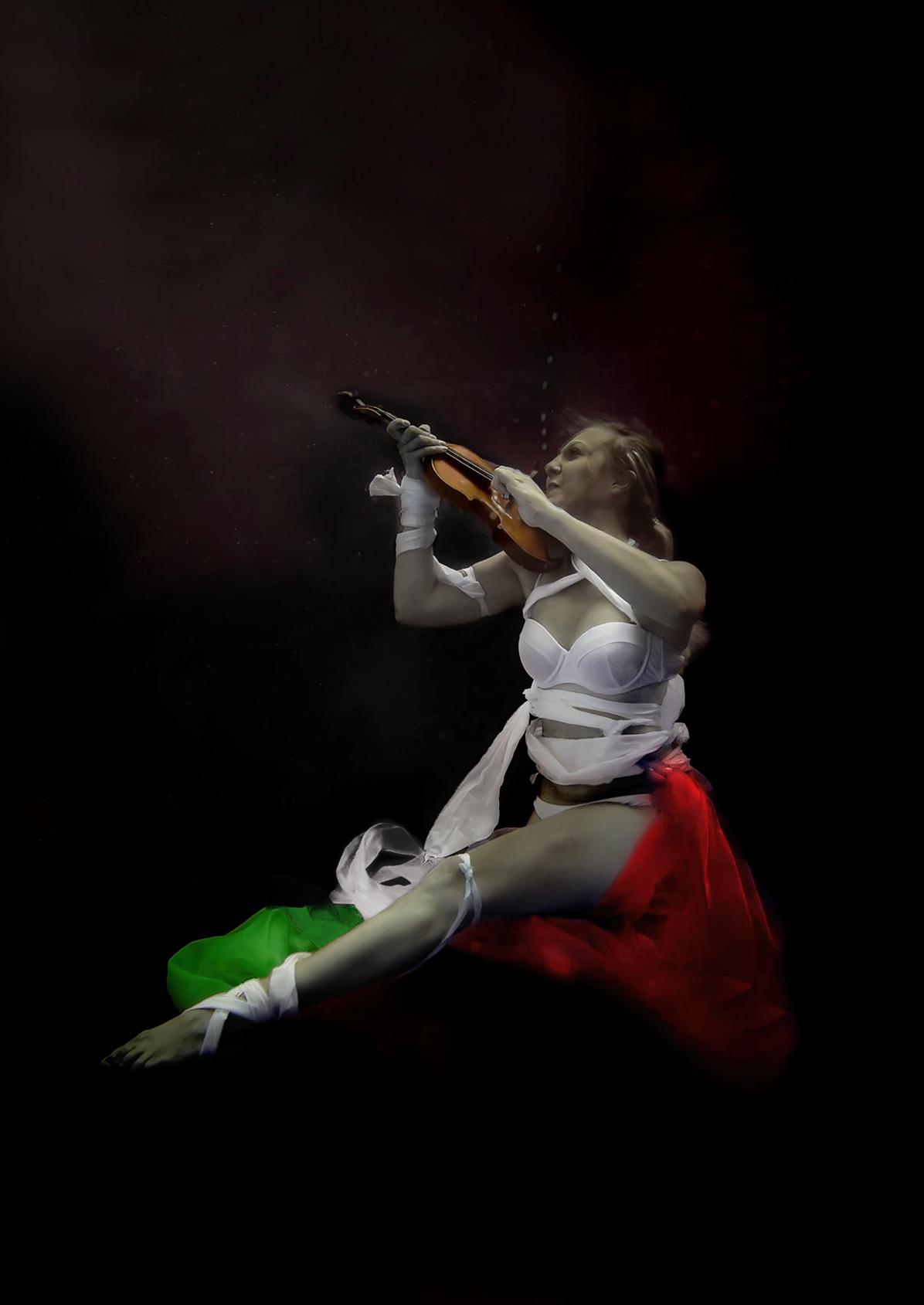War ... or Peace?







Nixora Group supports Banks and Financial Institutions with improving and excelling in data management, business and risk analytics, and compliance reporting




www.nixoragroup.com.au contact@nixoragroup.com.au
Please support Australia for UNHCR’s Afghanistan Appeal
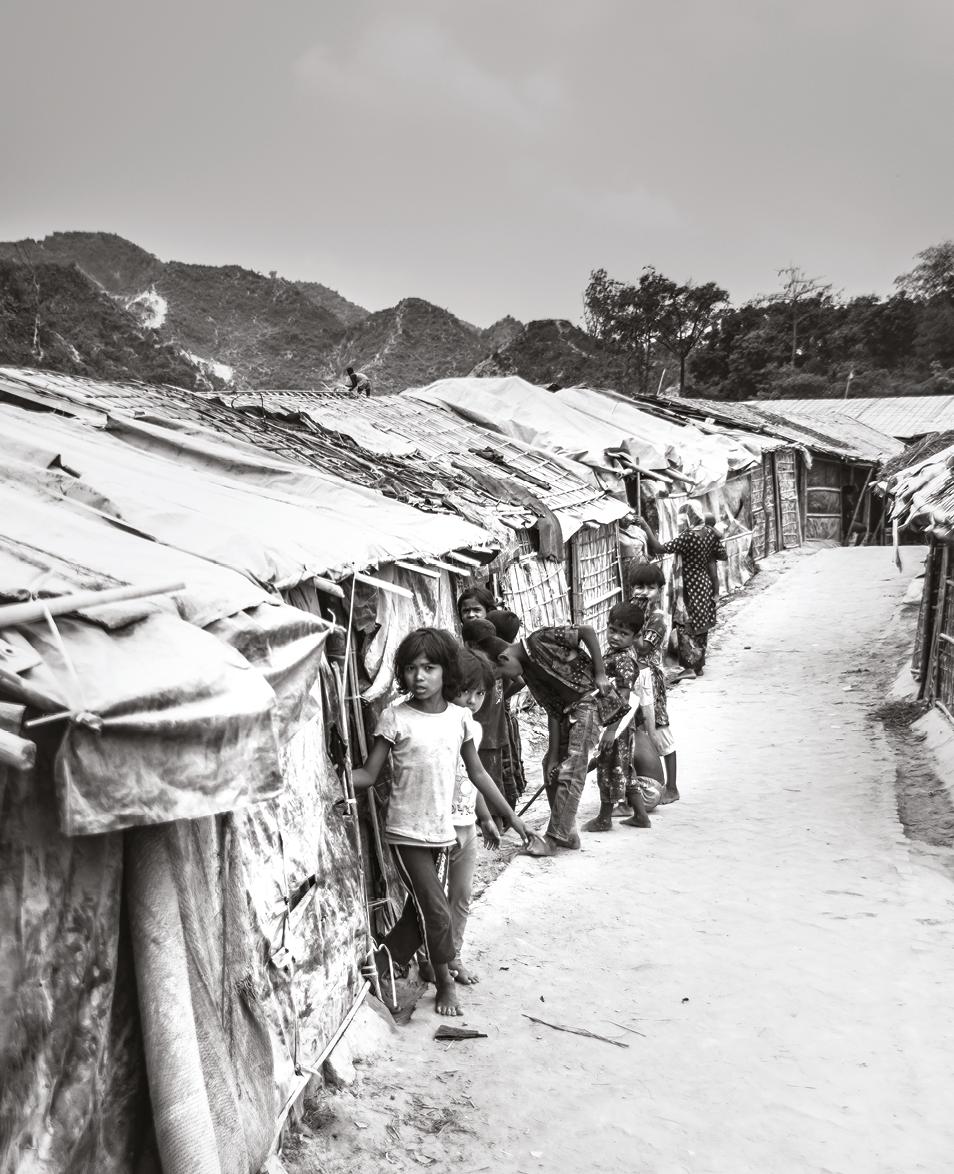


Since the start of the year, conflict has already driven some 665,000 vulnerable people out of their homes – and numbers are growing by the day unrefugees.org.au/segmento

Peter Brodbeck
Vincenzo Cascone
Renato Colangelo Cam Grove Sebastiano Motta Max Rommel Emilio Tini Gloria Torquarti Carla Trigilia Mark Wiesmayr
Gabriel Arata Lucia Barbera Nataša Ciabatti Ambra Dalmasso Natalie Di Pasquale Innocenza Giannuzzi Jytte Holmqvist Elisa Lolicata Marta Nicolazzo Martin Plowman Carla Trigilia Isabella Vagnoni Chris Valcanov Angela Viora

Phil Peluso and Giovanni Butera segmento@segmento.com.au
Nataša Ciabatti natasa.segmento@nixoragroup.com.au
Managing Editor Antonina Petrolito
Graphic Artist
Aurora Delfino aurora.delfino@gmail.com
Advertising on Segmento magazine and website www.segmento.com.au/advertising Ph +61 410 860 036
For features, articles and editorial submission natasa.segmento@nixoragroup.com.au


For general enquiries +61 410 860 036 segmento@segmento.com.au
Distribution
AU Melbourne
AU Sydney AU Perth AU Adelaide AU Brisbane AU ACT AU Cairns CN Beijing JP Tokyo NZ Auckland SIN Singapore
Subscription www.segmento.com.au/signup-page segmento@segmento.com.au
Back Issues segmento@segmento.com.au
Segmento
The UN Refugee Agency is dedicated to saving lives, protecting rights and building a better future for refugees, forcibly displaced communities and stateless people. For donations please contact partnershipssg@unhcr.org
www.donorbox.org/green-up-to-cool-down


The International Specialised Skills Institute (ISS Institute) exists to develop an innovative, skilled, and smart Australia by cultivating the mastery and knowledge of talented Australians through international applied research (i.e., industry-based) Fellowships. www.issinstitute.org.au

 The ISS Institute is a registered charity. All donations are fully tax deductible and go directly to fund Fellowships and education programs for Fellows.
Picture credit: Amy Franz, Italian Australian Foundation Fellow 2021
The ISS Institute is a registered charity. All donations are fully tax deductible and go directly to fund Fellowships and education programs for Fellows.
Picture credit: Amy Franz, Italian Australian Foundation Fellow 2021
The creative energy of life flows, like ink, out of the pen of Giuseppe Ungaretti to remind us that life acquires meaning in the face of death. So, the value of peace is understood in light of war, as Tolstoy conveys in his novel War and Peace. Why the choice of a Russian author at a time when war is being waged by Russia?
Because Ungaretti’s work is not only Italian heritage and Tolstoy’s work is not only Russian heritage. Both contribute to the shared heritage of humanity and this unites us all.
Yet, life is not the absence of death, and peace is not simply the absence of war. Peace is achieved in the search for justice, and conflict is at times necessary. When Leo Tolstoy decides to write historical fiction, he does so with an intent, becoming more realistic in his accounts than any historian could. How is this even possible? Because history, as he shows, cannot be fully understood; or, in his words:
You say I don’t know Russia. No, I know my own subjective Russia, which I look at through my little prism. If the soap bubble has burst for you and me, this is also proof that we are blowing a new bubble which we can’t yet see.
(Tolstoy, 1978, p. 145)
Is the great writer suggesting that we are insignificant and should do nothing in the face of history? Quite the opposite. Tolstoy, a dissident, shows us the tragedy of war and reminds us of the value of life,

which must continue in spite of all. What can you expect from this issue, then?
In Art & Culture, Vince Colosimo is the protagonist both of the cinema set and of a movie about the consequences of war for humanity. You will also read a much needed reconstruction of the history of the most popular song of resistance, “Bella Ciao,” and learn about the existence of a Japanese film set in World War II … in the Adriatic Sea!

In Social & Global Engagement, you will meet the newly appointed Italian consul for Queensland and the Northern Territory, Luna Angelini Marinucci, talking about intergenerational conflict, while Paolo Baracchi discusses the power of culture as an instrument of peace.

In Tourism & Places, you will be guided across the ancient Roman ruins in Tunisia, and in Food & Cuisine, you will find SlowFood President Barbara Nappini. In Fashion & Design, you will discover social activism through creativity, while in Business & Innovation, Dhebora Mirabelli shares a valuable initiative for Sicilian enterprises and entrepreneurs.
Buona lettura!







Lolicata Success Beoyond the Boardroom by Natalie Di Pasquale
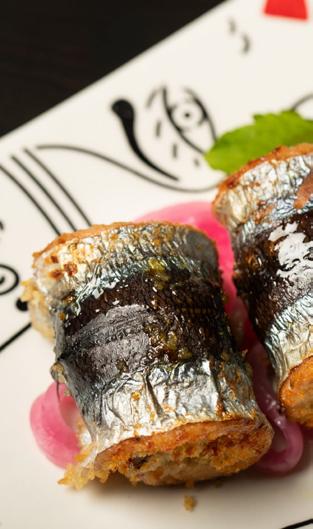

Luna Angelini Marinucci is the newly appointed Italian consul of Queensland and the Northern Territory, the largest consular district in Australia. An energetic young woman, she intends to bridge the gap between newer and older generations of Italo-Australians.
Italian society is constantly evolving, and as society changes, so do language and culture, and the XXII SETTIMANA
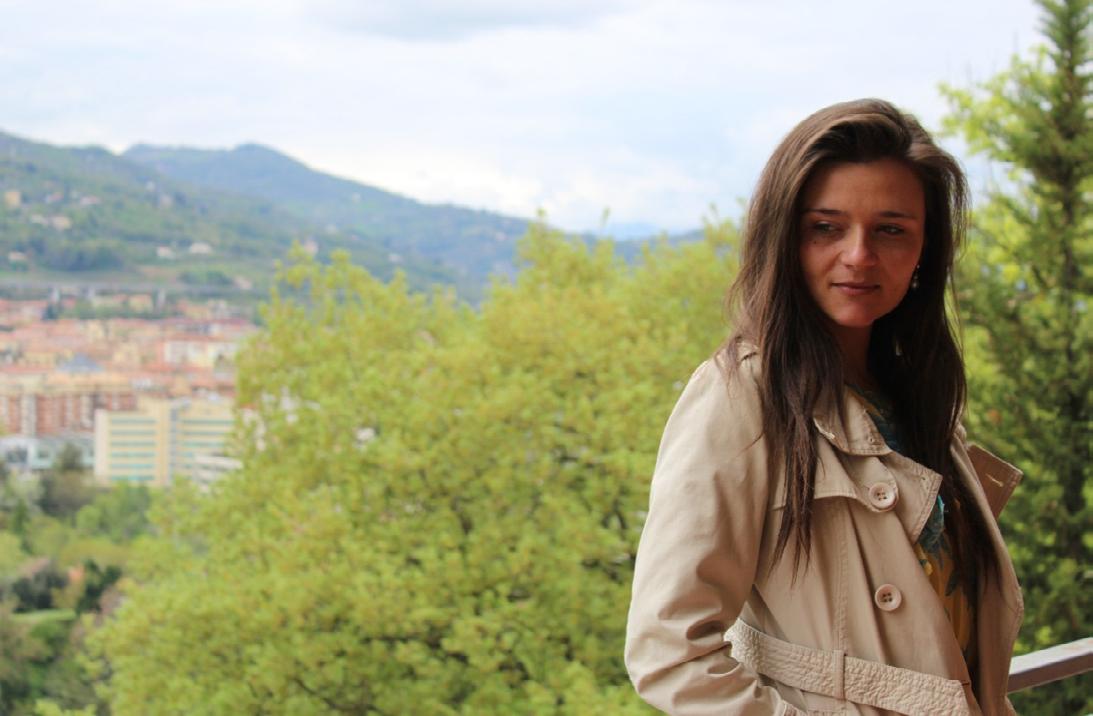
DELLA LINGUA ITALIANA NEL MONDO, celebrated across the world this October, is emblematic of this change. Segmento meets Luna Angelini Marinucci to discuss the role of consulates to promote understanding of difference within the Italian community in Australia.
As a young Italian consul in Australia, you represent both the older generation of Italo-Australians and their descendants as well as the younger Italians who are now arriving again after the end of travel restrictions. How do you view your role vis-à-vis these two groups?
When I took office in Brisbane last May, I became immediately aware that the
AND MY ROLE IS TO FACILITATE THE TRANSITION”
community I am here to serve is mainly made up of two large groups. There are the Italo-Australians of second or third generation, who often lost their Italian citizenship because, by law, the migrants from the 50s, 60s, and 70s had to relinquish it in order to become Australian citizens. Even if on paper they might not be of Italian nationality, they maintain a strong Italian cultural identity. In fact, most of them speak Italian or a dialect and they have kept the Italian traditions alive, also by founding the numerous regional associations –in Brisbane alone there are 11! – where today they still gather, play cards, and listen and dance to folkloric music. Then there is the new generation of immigrants. They are those who arrived and continue to arrive in Australia, often thanks to the Working Holiday Visa program, which was updated in July this year to be made available to all Italian citizens between 18 and 35. As they grew up in Italy, they have a very different vision of Italy, and so the cultural gap between these two groups is quite huge: if the former group listens to Modugno, younger Italians listen to Måneskin! Rather than relying on institutions and associations, they have more spontaneous forms of gathering and this makes it more difficult to reach them.
So, what is the role of consulates in bridging these differences?
My personal mission, as a junior consul, is to reach out to these new migrants,
bring together these different generations, and eventually bridge the cultural gap that exists between them. Obviously, the consulate is the point of contact between individuals and institutions. We guarantee

assistance to anyone in need, and I’d like to encourage everyone who is in Australia, even for a short time, to register their presence. In addition, the consulate supports any initiatives launched by the Italian government. For example, all Italian diplomatic and consular offices around the world are now celebrating the Week of the Italian Language in the World, and this year, the XXII SETTIMANA DELLA LINGUA ITALIANA NEL MONDO is emblematic of the cultural change that has been happening in Italy as it is titled “L'italiano e i giovani. Come scusa? Non ti followo.” It is clear, and natural, that the languages (including the dialects) spoken today are very different from the Italian (and dialects) spoken in the 50s.
Could language be the instrument to unite the generations then?
Language and culture are the bearer of peace, and anything created in Italy carries soft power, which is a stabilizing and fundamental element for Italy and the continuity of its role in the world. Apart from the events organized annually for the Week of the Italian Language in the
World, the consulate promotes exchanges for students of Italian, professional development for language teachers, exhibitions, and seminars.
When can we expect to hear Måneskin and Modugno in the same event?
Many initiatives can be organized; for example, one I particularly loved was when Italian children in kindergarten sang in residential aged care centers, where many Italo-Australians are living. The older generation has got a lot to offer to new migrants, and new migrants are the ones we need to carry on their legacy. Providing opportunities for these two groups to get into contact is key for the survival of Italian culture in Australia, which, as any culture, must change to survive. And change is never painless. It requires conflict, it requires taking a position, and not giving up when told it is not the way we do things. But again, my role is to make this transition as smooth as possible. So, Måneskin and Modugno in the same concert? I believe we won't need to wait that long!

Paolo Baracchi is well-known and respected in the Italian-Australian community in Melbourne for his role as cultural program manager at CO.AS.IT. Segmento talked to Paolo about the importance of acknowledging and nurturing multiculturalism in promoting acceptance and unity.
Can “culture” become an instrument for “peace”? I have a passion for etymology, and the origin of words can tell us a lot about their deepest meaning and potential. Peace derives from Sanskrit pac – pak – pag, meaning “to fasten,” “to tie together,” or “to unite.” The Latin term cultura , from cùltus , còlere , indicates “cultivating the land, growing something.”
In those words, we cross borders and meanings, in a way that mirrors Paolo’s mission so well: connections, growth, and collectiveness are the pillars of his work in sharing knowledge and building harmony across communities.

I met Paolo in the Carlton headquarters of CO.AS.IT., a charitable institution operating in Victoria since 1968 to promote the general well-being of the Italian-Australian community. Born as the Italian Assistance Association to actively promote and support the integration of Italian migrants into the social fabric of Australia, CO.AS.IT. has developed a full range of services and programs in the aged care, education, culture, and heritage sectors. As an ancient, solid tree, CO.AS.IT. never forgets its past: the story roots of the Italian presence in Australia is well-documented in the Italian Historical Society, established in 1980 to document, preserve, and promote the history of Italian migration and settlement down under through images, documents, histories, and objects from the gold rush to the present. Part of the collection is hosted in the Museo Italiano, which is open to
the public and features a special program for school groups. CO.AS.IT., moreover, continues to honor its original mission by providing support to the elderly through home care assistance and social support group programs. Don’t believe that this is all!
Far from being mired in the past, Paolo and his colleagues in the Italian Language, Culture and Heritage Department keep moving with the times by offering Italian language classes for all levels, support services for teachers of Italian, and a cultural program that includes art exhibitions, music performances, and lectures on the most contemporary topics.
Paolo, how do you ensure that CO.AS.IT. maintains well-grounded roots while it keeps growing and branching out?
“My role here as the cultural program manager is one of both privilege and responsibility and consists of offering a varied cultural program based on the synergy between three key groups: the first and most important one is the community, especially the Italian one, but not only. Our mission today is to reach and connect with other communities that constitute the Australian multicultural landscape, as well as to create a dialogue between diverse generations within the Italian groups.” Indeed, CO.AS.IT. Museo Italiano belongs to the network of the Multicultural Museums of Victoria, together with the Jewish Museum of Australia, the Chinese Museum, the Islamic Museum of Australia and the Hellenic Museum. The five museums collaborate on a regular basis.
The second group in this synergy consists of creative people such as artists, from painters to performers and musicians, writers, and poets … in Paul’s words, “the culture makers.” He continues, “Some of them are established and others are emerging, and we welcome both equally because we firmly believe in initiating a cultural discourse that is democratic, where there are no strict boundaries between the creatives and the spectators. Very often, indeed, the creatives belong to the ItalianAustralian community themselves.”
Gli studiosi , in Paolo's words, constitutes the third part of this triptych: these are professional researchers and scholars –both freelance and affiliated to universities
and other institutions, writers, and teachers of Italian – who research and write on the Italian community, and its continuing history of migration and settlement. In 2019, Italian scholar Francesco Ricatti presented here at CO.AS.IT. Italians in Australia: History, Memory, Identity, his book on the history of Italian migration to Australia over the past 150 years. Paolo recalls that over 150 people of varied ages and backgrounds attended the talk: from older Italian-Australians and their descendants to the new generation of Italian expatriates, but also non-Italians, scholars and students, academic and mostly non-academic audience members. They were all equally engaged, and Paolo's pride lies in making high-quality research accessible to anybody in the community “without lowering the quality, and watering down the force, and the message of these works.” Through this approach, a relationship of exchange is established between presenters, artists, scholars, and the community audience, who actively dialogues and participates as a contributor as well. Paolo is the “wizard” who manages energies and synergies.

The latest issues of Segmento explored themes such as identity and belonging, beauty, and now war and peace. How does CO.AS.IT relate to these concepts?
“Well, I have no definite ideas about these concepts because of their complexity, especially in a world that is in constant and rapid evolution.” Identity, however, is the element to which Paolo’s work relates the most. He explains that “identity cannot be a monolithic and fixed concept solely relying on blood,
language, or certain cultural practices … Identity is rather a multifaceted prism, a concept that is amplified by migration and multiculturalism.”
Originally from an Italian-English family himself, and creating here an ItalianChinese-Australian one, Paolo thinks that in this space of multilingualism and multiculturalism, “one has both the burden and the privilege of constantly negotiating with the identity received at birth and at home, within the family, and the plurality of identities encountered in other environments growing up: school, work, friends, and of course, migration.”
As both past and present migrants know, this third space can turn into a space of non-belonging, when one feels being between two or more cultures, languages, and countries without fully fitting in any – this can then become an area of conflict and violence when it comes to racism and difficulties of integration, as sadly experienced by Italians coming to Australia after World War II. Yet this in-betweenness can also become a harmonious and peaceful space of discovery and acceptance, where different cultures and identities connect and merge. When this happens, Paolo says, we inhabit “a fertile terrain for creativity and openness by making it our own unique space of identity: one can be Italian and Australian and Greek, for example, without having to choose one over the other.”
The peaceful coexistence of cultures can start from the single individual, then?
“Yes, but I believe that collectivity plays a fundamental role in this process”, Paolo explains. “The Italian-Australian
culture is a creative product in its own right, born here and belonging to both the broader Australian landscape and the Italian diasporic one. Here at CO.AS.IT., we aim to constantly mirror and nurture this twofold aspect of the community so that any member can relate to it. We do so by acknowledging our diasporic origins, which are our roots, while at the same time moving forward through the ongoing relationship with contemporary Italy, especially thanks to the new generations of both Italian-Australians and Italian [expatriates].” The challenge is constantly working on a multilayered identity, which is both transcultural and transgenerational. Paolo sees this as an opportunity because “when a culture acknowledges multiplicity in its specificity, then that culture becomes confident in its own right, sicura di sé , and can be open to sharing its knowledge and perspectives with other cultures in peaceful and enriching ways.”

by
Melbourne-based Argentinian pianist Andrea Katz is steeped in a storytelling tradition. Director of Songmakers Australia, she is as familiar with the Australasian music scene as the international stage, connecting with audiences through recorded and live music through regular travel abroad.

her audiences to interact or behave a certain way, she responds that “Things are changing regarding audience’s behavior and participation.” Quoting Verdi in his native Italian, she adds:
Torniamo all’antiqua e facciamo progresso. We are going back, hopefully, to the time when audiences were allowed to express their excitement and could interact with the performers. Of course, it depends on what repertoire you are presenting but that can be made very clear by your behavior on stage.
Katz’s personal and professional journey across continents began when she left Argentina to begin a new chapter, first in Paris and then in Israel. She moved to Australia in 1994, lived and worked in Sydney for 15 years, before moving to Melbourne after being invited by her colleague and “fellow songmaker Merlyn Quaife to join her on the staff of the Melbourne Conservatorium.” Italian on her mother’s side, Katz speaks Spanish and Italian fluently and is no stranger to the tarantella . When asked if she expects
Katz also has Jewish heritage and lived in Israel for 11 years, completed her second degree in Jerusalem, and started her opera coach career with the New Israeli Opera in Tel Aviv. She feels a strong affinity with Israel as a country and community: “My father’s family is Jewish, from Ukraine, so Israel was also home to me. I particularly enjoyed the Levantine idiosyncrasies and the amazing history, right at your feet.” Her curiosity in music, traditions, and the world around her has led to great cultural insights and a perfection of musical skills. She shares her specialized understanding of, for example, Argentinian tango music traditions with her cohorts of students at the University of Melbourne – her main academic affiliation. She also teaches master classes at the School of Music at the National University of San Juan, Argentina.
Alongside fellow Argentinians Martha Argerich and Daniel Barenboim, who
“stem from the same piano school of Maestro Vincenzo Scaramuzza,” Katz has left a veritable musical legacy. A dynamic and vibrant pianist, she has performed at a multitude of venues nationally and abroad. She gave an impressive rendition of Astor Piazzolla in a concert titled Nostalgia: Piazzolla 101, at Tempo Rubato in Brunswick, Melbourne, in April 2022. Her vibrant and dynamic and searingly melancholic piano music filled the room. Small in stature but with a commanding presence, she collaborates regularly with her students on vocals – as was the case this particular night, when bass-baritone Nicholas Dinopoulos added his narrative voice to the repertoire, and sounds from regional Argentina matched with lyrics of love, nostalgia, longing, and belonging that ultimately hold universal value. When asked about the timeless relevance of tango, Katz – herself an aficionado of Astor Piazzolla and Carlos Gardel – stresses:
People all over the world are fascinated by tango, be it traditional or modern. Piazzolla broke the mold of raw, smouldering passions by incorporating his love of Bach into the rhythmical patterns. He was very unpopular in Argentina until he had great success in Europe.

She believes in the ultimate global relevance of classical music and that it elevates us to new heights. Attracted to a variety of different composers and styles, she quotes John Lennon’s famous songline: “Imagine there are no countries.”
When the pandemic hit in 2019, the city of Melbourne was subjected to an extended period of lockdown and international borders closed, Katz kept active in her multifaceted university role. She explains that the entire Faculty of Arts was moved online in only 4 days. Even if she experienced a loss of performances, Katz and colleagues were able to “collaborate with trailblazing organizations like the Australian Digital Concert Hall and other organizations and festivals in Australia and abroad. It also allowed me to develop new teaching techniques that made it possible for my young students to complete their assignments and examinations online.” Katz occasionally has to play unknown repertoire for her students but the repertoire she chooses for her ensembles is “always very close to my heart.” She concludes our interview by emphasizing that “Argentina will always be my country, but I am very happy in Melbourne.”

Lorenzo Zuffi thinks of another great classic of literature, The Divine Comedy by Dante Alighieri.
Of course, I will say Dante! When writing his Commedia, Dante was struggling, and we know this from the beginning: “Midway upon the journey of our life / I found myself within a forest dark, / For the straightforward pathway had been lost.” It might sound like a cliché, but these lines point to the spiritual journey Dante undertakes to heal his inner conflicts: by immersing himself in the darkness of his sorrows, he is able to find God – a Chirstian God, of course. But God in Dante is spiritual more than religious. What provides me with inexhaustible material for my work is Dante’s approach to the theme of life represented as an arc, from when he descends into Hell until the moment he exits Paradise, that temporal arc of only a few days in the Commedia summarizes all the battles we have to fight to stay alive and, eventually, to find peace.
Michelangelo is one of the greatest geniuses of the Italian Renaissance. Throughout his life, he was tormented by the clashing encounter of the hardness of stone, a metaphor for suffering and passion that he himself embodied, and the spirit within matter, called concept
The function of the artist for Michelangelo was thus to adapt "matter" and "concept," and the effort to translate a "concept" into work attracted the sculptor more than the practical refinement he often left to his students.

Michelangelo's art can be summed up in the useful strokes of the chisel to nullify his own ego, so much so that he himself became the secret soul of stone and thus of eternity


Journalist, cultural anthropology researcher, writer, analyst, and expert on iconography and iconology of works of art

Tena Prelec, an Italian academic hailing from the Balkans, recommends an author who dispels the myths around the region’s recent conflicts.

The 1990s wars in the Balkans were not only destructive for the havoc they wrought during that decade but also for their enduring legacy of divisions. These wars were often misunderstood and relegated to the status of “ethnic conflicts.” Superficial narratives of foreign writers catapulted into this region do little to dispel the myths and help a better understanding of the intricate situation and its aftermath. Talented writers like Azra Nuhefendić have helped bring the nuances of the wars in the Balkans to Italian readers. Their searing memories, sometimes appropriated by more established writers, are a precious window through which to grasp the facts and the emotions as they were experienced on the ground. Often unsung, such voices deserve to be heard loud and clear.
The former mayor of Riace, Domenico “Mimmo” Lucano, is a symbol of the fight for freedom and human rights of all people who leave their homes in search of a better future.

During his mandate as mayor of the small town in the province of Reggio Calabria, between 2004 and 2018, he allowed migrants and refugees to settle in the many abandoned properties and to set up businesses, revitalizing the local economy and preventing the closure of the local school.

Praised abroad – he was nominated one of the most influential political leaders by Fortune magazine and awarded the International Peace Prize by the German city of Dresden in 2017.

Tell us about an Italian whose work represents both war and peace.

“Acting is the study of human nature, and if you can incorporate all of that in your work, you can only prosper, learn, and thrive,” says Vince. That is what he intends to bring in his new work, soon in preproduction. Bonegilla promises to be a very compelling movie that depicts Bonegilla history, through the ruse of a spy story. Strangely enough, no movies have yet been made about Bonegilla, despite its undoubted and pivotal influence on Australian culture and history. For those who lack knowledge of Australian history, in fact, Bonegilla was one of the major immigration camps of Australia and was located in Victoria, just 300 kilometers from Melbourne. As a postwar immigration camp, Bonegilla was presented to the world via promotional videos and other forms of propaganda as a great opportunity for a better life, with the very tempting promise of a job and a bright future for the whole family as soon as one landed in the “lucky country.”
Although Vince himself doesn’t have any link to Bonegilla in his family, he gave us a lesson of what family means to him, and how such roots can shape us, without our knowing. Vince had one of his most lifechanging experiences during the making of an episode (which took a year and a half to research) about his origins for the SBS television series Who do you think you are? , where he literally traveled through his family history to ultimately discover who he really is, who preceded him, and through what sort of hell his family had to walk through when they migrated to Australia. Although they didn’t have to go through Bonegilla, they know many other migrants who did.

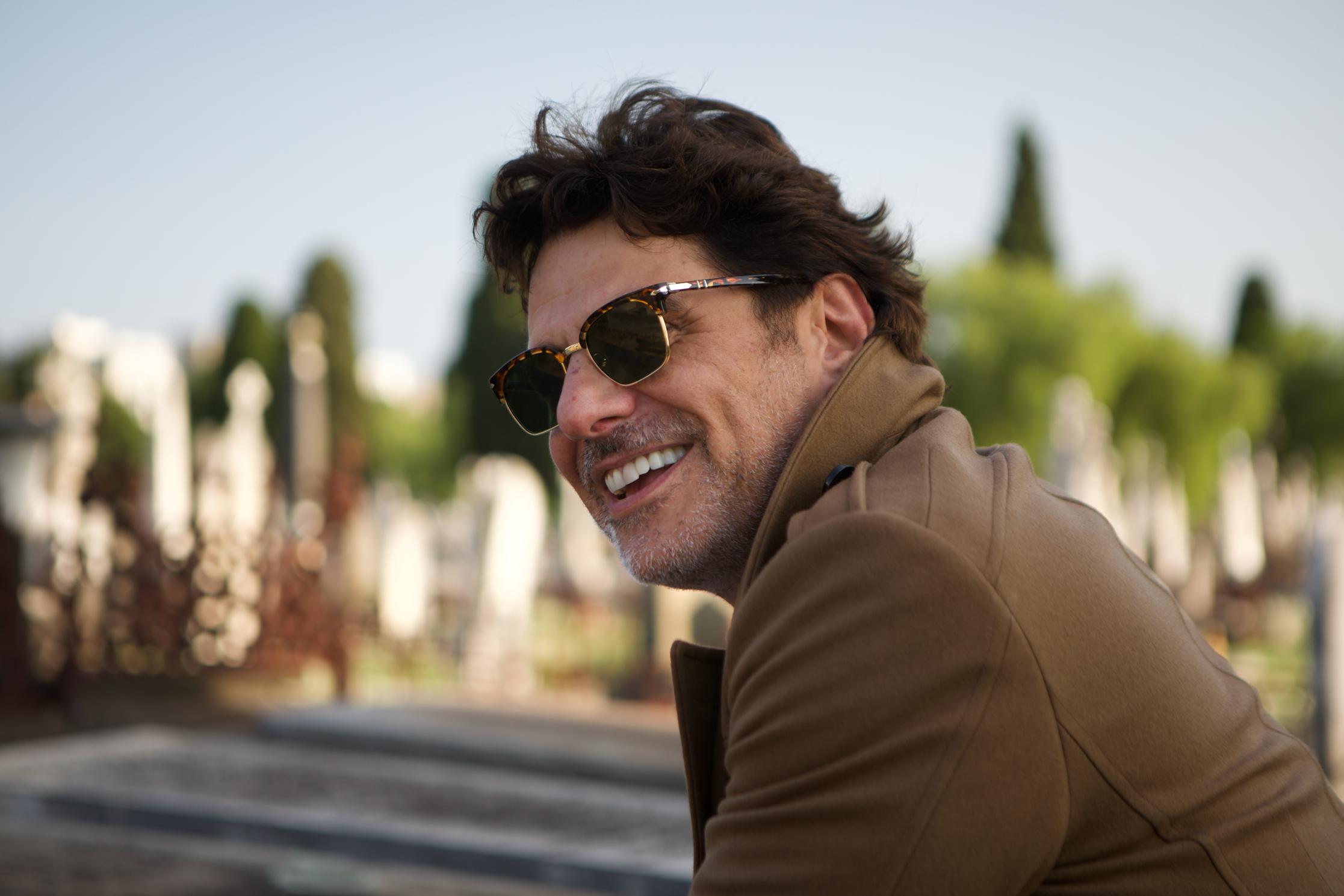
I am quite fascinated by this story because it feels like this part of history, like Aboriginal history, was kept hidden from us, and I can’t wait for this story to be told because it tells so much about where we come from, how we immigrated, the struggles people went through to move to the other side of the world and pave the way for others … I don’t know why they chose here. There was work here, I suppose, but I always wondered, why Australia?
Whereas the government propaganda painted a rosy, idyllic picture of the camp, the reality was far darker than that. What the commercials showed was nothing like the crude truth. As expected, in all documentaries available online as testimony of an historical turning point for our community, we notice how the presence alone of the videographer strongly influenced the behavior of workers at the facility. Bonegilla was, after all, mostly an enticing bait that soon became a nightmare for many. For those who chose to follow “the dream” by putting their whole world in a suitcase, the journey would have started as soon as they boarded the ship. Hard to fathom how both exciting and dreadful it must have been. The so-called land of opportunity was far, at a distance that must have seemed like light years away from home.
“Imagine the paranoia. They embarked on this journey for their family’s sake, they must have been so scared of failure,” adds Vince. Once arrived, migrants would soon realize how far from immediate that longdreamed life would be. In order to attain a job, families were often forced to split up.
No work meant being sent back home, all hopes and expectations were over; and to many; it would mean the end; depression hit hard, hence the many suicides that occurred in Bonegilla. “There are still many modern day examples of Bonegilla around us,” continues Vince. “Today’s detention centers are far away – far enough we are not forced to see them.”
“They must have felt like prisoners of war,” continues Vince, “people detained before walking out into society. There must have been so much miscommunication and misunderstanding between the “guards” and the “prisoners.” To those who managed Bonegilla, this camp should have looked like a blessing in comparison to the nightmarish experiences of wars and Nazi concentration camps. The very epitome of every culture, food, became the cause, or effect, of conflict. When all dreams seemed to vanish, frustration reached boiling point. After simmering for years, it eventually exploded. At the end of the day, something had to give. Despair and extreme frustration pushed people over the edge, leading to several riots. Reasons for those occurrences can be found in various factors, although very hard to pinpoint without knee-jerk judgments of incompetence and inexperience.
I can relate to my character because he too is of Italian heritage. It’s funny, but back in the days, this sort of role used to be called “typecast” but I don’t call it being typecast, every character is different, I don’t believe in this. The fact that he is of Italian background, son of immigrants, works beautifully for me, in fact is a plus. I can take on his
struggles, the tragedy, the passion of this character. When I was a student and nobody imagined I could act, I found the strength to bring out my innate passion for acting, and I say that because I want to inspire other young people, who get typecast in society, to break down the barriers and bring new life to the existing society.

What we take for granted these days – such as numerous Italian restaurants, German, Spanish – all these amazing cuisines that we all love so much probably had their beginnings right there, in the dirty kitchens of Bonegilla, when the refugees, after the riot of 1952, were finally granted the possibility of cooking for themselves rather than endure nasty canned food, so very degrading for what was left of their cultural dignity. More than 350,000 migrants came from Bonegilla, having had their first taste of Australia. They are those who could call the Bonegilla camp their first home, to some extent their first achievement of a journey in the making. And acting is a journey too.
I look forward to playing this character. It is always a work in progress, there is always a beginning, a middle, and an end, and this is the beauty of a film, compared to a series, where you don’t know exactly where the character is going. When I read the script, I can immerse myself in the character.
In the end, despite the differences and controversial mistreatment, and degradation, Bonegilla did in fact help contribute to shaping the multicultural Australia that we know and live in today.
In today’s world, things are not that different: despite plenty of progress, law changes, people still go through war to seek peace. If those immigration camps are no more a thing, the Bonegilla movie will help remind us that in today’s world we still have refugee camps spread around Australia and the world where people from different ethnicities still struggle, living in a limbo of so-called justice to hopefully see the light at the end of the tunnel. The question is, “how far have we really progressed?”
Porco Rosso is now considered a powerful anti-war film. But can an animated film about a man cursed with a pig’s head actually deal with politics in the real world?

One of my favorite movies about Italy is Porco Rosso, a film about a wisecracking anthropomorphic pig who flies a red seaplane. And it’s not even Italian – it was made in 1992 by famed Japanese director and founder of Studio Ghibli, Hayao Miyazaki. When it was released, it was praised for its humor and artwork – in my humble opinion, aerial flight has never been captured better on film (sorry, Top Gun, although you get points for using real aircraft).
Set in an alternate 1929 on the Italian and Istrian shores of the Adriatic Sea, Porco Rosso follows the exploits of Italian fighter ace turned bounty hunter Marco Pagot (voiced by Michael Keaton in the quite excellent English-language dub, which I’ll be referring to throughout). A curse has turned Marco into a pig, though how and why is never fully explained. When hotshot American pilot Donald
Curtis (Cary Elwes) turns up at the Hotel Adriano – owned by the multitalented Gina (Susan Egan) with whom Marco shares an unresolved romantic attraction – the brash flyer strikes a bargain with local sky pirates to eliminate Marco in exchange for a free pass to marry Gina, who doesn’t care for the American at all. Marco narrowly survives the ambush and heads to Milan to have his beloved flying boat repaired by Signor Piccolo (David Ogden Stiers) and his plucky 17-year-old granddaughter Fio (Kimberly WilliamsPaisley). Warned by a pilot friend that the fascist secret police are on his curly tail, Marco returns to his secret home base, taking Fio along with him as a kind of apprentice. Curtis and the sky pirates corner Marco again and challenge him to a race. The stakes are high – if Marco wins, Curtis will pay all his repair bills; if Curtis wins, Fio must marry him.
Porco Rosso could have been a story about tragic characters trying to hold onto their humanity as the world slides into fascism and war, in the vein of Cabaret (1972) or Babylon Berlin (2017, ongoing). But there are no real confrontations in the film, and no overriding sense of menace from the fascists. Instead, Porco Rosso takes a stand against fascism by telling a story suspended in an alternate and indeterminate space where oppressive power cannot reach.
The most obvious of these states of suspension is the Scarlet Pig himself, a character that is half-human, halfbeast. Marco is an outsider; he no longer
belongs to either world. And while he can’t escape his human feelings of guilt, he can’t live in the present like an animal, either. However, it is during one of the film’s key aerial scenes that the most enigmatic moment of suspension takes place. Marco recounts an experience from the Great War: during a deadly dogfight, Marco momentarily passes out. Upon regaining consciousness, he finds himself skimming above the clouds, while high above him hundreds of aircraft float past in silent formation, drawn to some unseen destination like moths to a light. For a few endless moments, Marco is literally suspended between life and death until his plane drops down through the clouds again, back into the world of the living. Only now Marco is transformed into a pig-headed human…
Overarching all these moments of suspension is the alternate interwar Italy in which Porco Rosso is set. The end of the film jumps ahead several decades – we learn about all the principal characters’ lives since the events of the film, but not once is World War II mentioned. Perhaps it never happened in this world.
This blissful, confrontation-free world is a retreat from the terrible realities of the 20th century. The construction of an alternate world where fascism and World War II didn’t happen is itself a kind of resistance. Porco Rosso’s powerful message is that if only we could see clearly the most important things right before us – the things that give us joy, the people who love
us – we might avoid being caught up by the demogogues and ideologies that can lead us to war and destruction. Marco and his friends don’t like fascism, but they’re not scared of it either. They simply don’t take it seriously.
This is where Porco Rosso’s act of resistance lies – if we don’t take ideologies of hate and division seriously, they cannot grow. This is not wishful thinking, it’s a way out of the cycle of conditioning and alienation that plagues our real world. Watching Porco Rosso is a powerfully liberating experience, and that’s not just because of the soaring animation. Make no mistake – beneath the whimsy and the slapstick humor and the wide-open skies, Porco Rosso is a resistance film. I like to think I’d never be a fascist myself; it’s just a shame that I can’t be a pig either.
A diorama depicting a scene from Porco Rosso as part of Studio Ghibli’s exhibition in Shanghai

The popular anti-fascist Italian song "Bella Ciao" is a symbol of resistance against any form of injustice throughout the world. But what of its origins? How has it come to be considered a hymn for humanity in the fight for freedom?

“Bella Ciao” (meaning Goodbye Beautiful) has been a significant song in my life. I learned it as a child from my elementary school teacher, and in my family, it provided the soundtrack for all the most important events. I remember that it was sung at weddings, grape harvests, as well as olive harvests. During my adolescence, when I used to go to the town square to celebrate Liberation Day on April 25, “Bella Ciao” was considered the symbol of the partisan and anti-fascist resistance.
Beyond its deep meaning, “Bella Ciao” has such a special melody that even when hearing it for the first time, it sounds very familiar. And despite being written by adults for adults, even children find it catchy. In fact, every time I sing it to my 3-month-old daughter, Gemma Vittoria, she listens with great interest, and looking me straight into the eyes, she starts to smile, as if it were an upbeat song.
In recent years, thanks to its melody and political meaning, “Bella Ciao” has
become increasingly popular everywhere people fight injustice in the struggle for freedom. As reported by RaiNews, it is now the anthem of the Ukrainian resistance against Vladimir Putin's invasion and for the anti-hijab protest of Iranian women against the government’s rules, following the death of 22-year-old Mahsa Amini, arrested for violating the law on compulsory veiling in public.
Using a metaphor, it's possible to say that nowadays the song runs in the videosphere like a relentless hare, and is not a coincidence that “Bella Ciao” is the most famous Italian song in the world, as argued in the homonymous book by historian Cesare Bermani.
“Bella Ciao” has reached new peaks of popularity thanks to the Netflix series Money Heist, so that even teenagers without knowledge of the history of the Italian resistance have memorized it and can sing it after watching one of the most in-demand shows in the world. As I was writing this article, the song was the subject of a public debate on social network sites because Italian singer Laura Pausini refused to sing it during the Spanish television show El Hormiguero. She explained: “I don't sing political songs, neither of the right nor of the left.” This refusal sparked a lot of criticism on the artist's Facebook page, because according to the numerous posts, “Bella Ciao” is not a political party song, but a song of freedom against tyranny. But what is the story behind this song, and how has it evolved?
According to La Gazzetta Italiana , the origins of “Bella Ciao” date back to the beginning of the 19th century in northern Italy, among the so-called mondine , the women who worked in the paddy fields of the Po River valley. It is said that they were

the first ones to sing it, but using different words to denounce the harsh conditions of their work.
“Bella Ciao” appears to be connected to Klezmer music, a traditional musical genre of the Ashkenazi Jews of Central and Eastern Europe, as reported by Redazione online . Its origin is attributed to Mishka Ziganoff, a gypsy musician from Odessa (Ukraine), who recorded the song for the first time in New York in 1919. According to this theory, “Bella Ciao” is the result of the Yiddish song titled “Koilen.”
As stated in the Italian newspaper Il Manifesto, the most widespread explanation of its origins is that it would have been sung during the Second World War by the anti-fascist resistance fighters as well as during the Italian civil war. In reality, it was the “fighting anthem” of the Maiella Brigade in the Abruzzo region. The words of the anthem take up the popular song “Fior di Tomba” and tell the story of a partisan who goes to fight the invader and asks his girlfriend to plant a flower on his grave, before shouting that he died for freedom.
“Bella Ciao” became famous after 1945, when the socialist press took it up, and an ethnographic magazine named La Lapa published it in 1953. According to the
Antiwar Songs blog, “Bella Ciao” spread thanks to the Italian socialist youth. During the first major World Festival of Youth and Students in Prague (1947), Budapest (1949), and Berlin (1951), people sang it because it is easy to sing and clap to the rhythm, and the refrain can be sung even by someone who does not know Italian. The song became known at a European level among the young left-wingers who participated in these international meetings in the postwar period. However, according to a 1953 article by Riccardo Longone in the Italian newspaper l'Unità , “Bella Ciao” was already known also in Korea and in China thanks to the festivals. The popularity of “Bella Ciao” grew in the 1960s, with a recording which became a hit and one of the most recognizable songs of the ItalianFrench actor and singer Yves Montand.
In 1964, the song became a successful political anthem when it was sung at the Spoleto Festival dei Due Mondi during the show, also titled Bella Ciao, which was conceived as a collage of folk songs by the group Nuovo Canzoniere Italiano. Four years later, in 1968, “Bella Ciao” was
sung on the occasion of the anti-capitalist protests of workers and students, especially in France and in Italy. At the beginning of the 1970s, “Bella Ciao” started to spread in Chile, where it was adopted – thanks to the musical band Quilapayun – during the cultural revolution of Salvador Allende's government, which was overthrown in 1973 by General Augusto Pinochet.
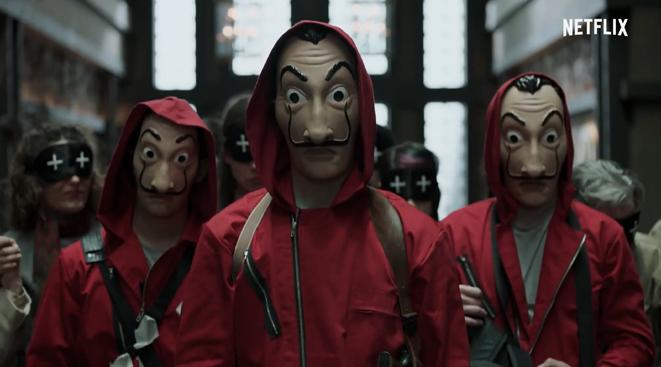
In addition to the Yves Montand's and Quilapayun's versions of the song, there is an Italian one by Milva, as well as those emanating from America, Bosnia, Argentina, France, England, and Turkey. In Italy, there is also a popular 1990s version by the Modena City Ramblers, which is possibly the most popular version among those of my generation.
“Bella Ciao” spread around the world and was adapted to suit different contexts and ideologies. It is a song that can be compared to a ball of yarn which can be difficult to unravel. Although its origins remain mysterious, the number of versions all over the world are testament to its relevance.




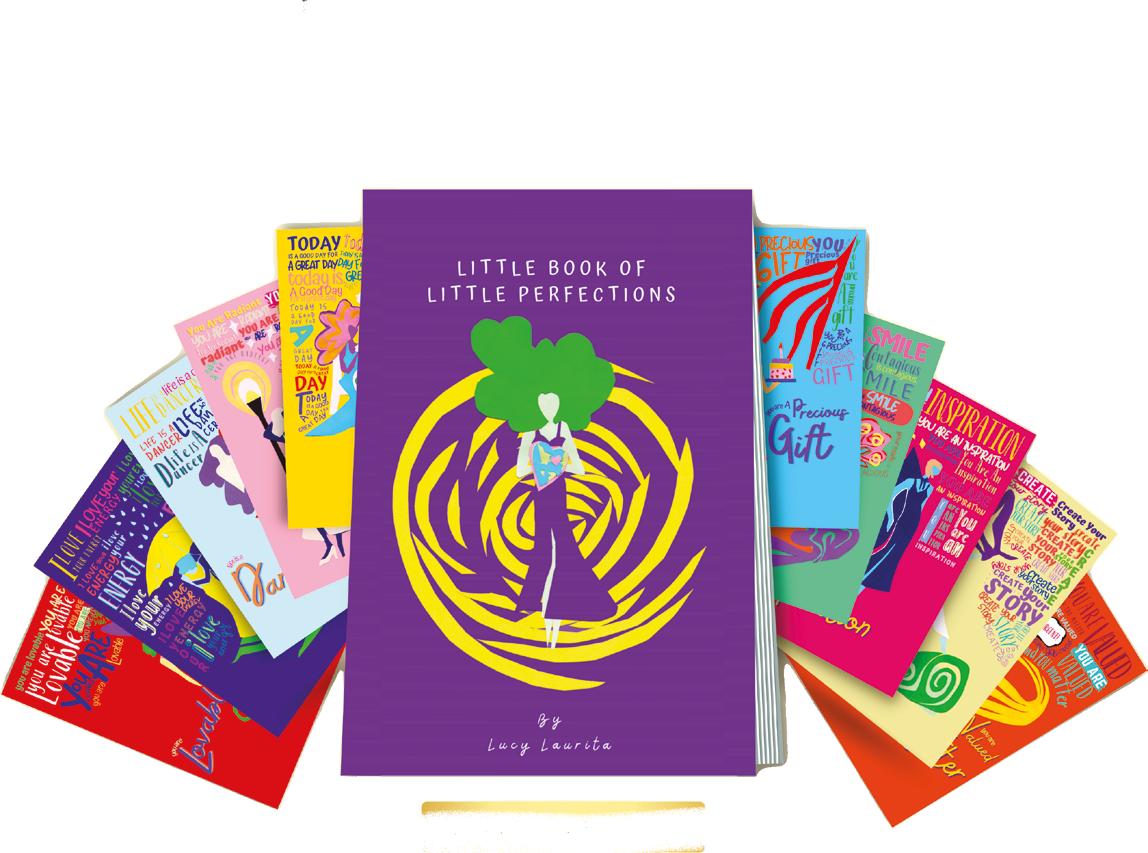

Andrea Cammarosano (artist and designer) and Leonardo Persico (stylist and art director) were driven to create TOOLS to help teenagers overcome the difficult situation of the post-pandemic period by giving them the opportunity to learn, express themselves, and create beautiful fashion:

Creating something beautiful, whether it is a fabric, a dress, or a photo is not just an aesthetic experience, but an activity that has real, tangible effects on the lives of people. It teaches us to relate to the world around us and that, despite things being messy, scattered, fragmented, it is possible to slowly reassemble the pieces and, from chaos, give shape to beauty.
In their large studio space at the crossroads of public housing and professional institutes, Andrea and Leonardo welcome once a month a group of teenagers, recruited through the local schools and the city’s social services. During the full-day workshops, these young people learn about textiles, clothing, and visual communication under the direction of the two founders and other professionals from the creative industries, including textile designers, tailors, a fashion editor, makeup artists, and photographers.
What happens when creativity, education, and social responsibility come together? TOOLS, the training project created by CLU++ER studio in Milan for young creatives, might just have the answer. Segmento spoke to Andrea Cammarosano, one of the founders of CLU++ER.
The project cycle lasts 6 months, at the end of which the creations are presented to the public, then made available for sale in a pop-up store thanks to the sponsor DADS. IT (Designer Archive Digital Store), a Florence-based collective that deals with guiding young designers in their first steps toward producing and distributing their own garments.
The pieces of Grafikissima – the collection designed together with Alesinja, Sefora, Camilla, Angel, Giulia, and Kohl from the first cycle of workshops –are all characterized by colorful motifs, printed on ecotwill and cotton poplin fabrics. These fabrics were realized by TheColorSoup, one of the sponsors of the project, through a technique called “pigment printing”: a sustainable process requiring low water consumption. A selection of the pieces can be bought on the CLU++ER website (https:// www.helloclutter.net/tools-sostieni). Proceeds from the sale of the garments are reinvested to fund future participants in the project, now in its second iteration. In addition to technical training, this new crop of industry hopefuls will learn in an environment that bears little resemblance to a school:

You have to have faith in small steps: from a few fragments of fabric a world can be invented, the knowledge of small techniques can create a job, and in this path you are not necessarily alone, but you act with the support of many hands and many heads together. The combination of creativity, technique, and sociability is the formula behind this project.
TOOLS is a safe space, far away from grades and assessments, a social space in which the business aspect emerges to give these young people a taste of the world of work that awaits them, where those who have struggled can overcome their difficulties and learn to express themselves through art, colors, fabrics. Creativity gives them a way to cope with, through beauty and inventiveness, the vicissitudes of life.
 by Isabella Vagnoni | Photography by Max Rommel
by Isabella Vagnoni | Photography by Max Rommel
Milton Glaser, famed graphic designer and cofounder of New York magazine once said, “There are three responses to a piece of design – yes, no and WOW! Wow is the one to aim for.” WOW! was definitely my reaction to the Created in Italy exhibit.
Created in Italy: An aptitude for the impossible showcases over 30 innovative pieces representing some of the most notable examples of contemporary Italian industrial design and technological innovation. Organized by the Istituto Italiano di Cultura (Italian Cultural Institute) of Melbourne and produced by the Directorate General for Cultural and Economic Promotion and Innovation of the Italian Ministry of Foreign Affairs and International Cooperation, the exhibit was conceived by the Director of the Istituto Italiano di Cultura of Melbourne, Angelo Gioè. Angelo engaged the best names of Italian industrial design – Mario Trimarchi (designer), and Odo Fioravanti and Giulio Iacchetti (curators), all winners of the prestigious industrial design award Compasso d'Oro – as well as Francesca Picchi (curator). The exhibit has been touring globally for a year and will continue to travel for another year thanks to consular networks.
I had the pleasure of seeing this incredible display in the creative space at the LCI Gallery, where it was presented in collaboration with LCI Melbourne and the Design Institute of Australia. I expected to see a coffee machine or a Vespa, objects more (stereo)typically Italian. Instead, I found fireproof material by Coex, biodegradable compostable bioplastics by Novamont, and a 3D multicolor printer by Eumakers, to mention a few. My jaw dropped with each design.
My favorite piece from the collection is a bendable speaker by K-Array. The number of sound engineering districts in Italy has risen, driven by the demand from musicians and engineers to meet specific acoustic and sound reproduction needs. K-Array designed the flexible Anakonda snake speaker, considered the first “folding” speaker in the history of sound dispersion. Designed in Florence, it is flexible, windable, crush-resistant, and truly innovative.

Established in 1961 as a small mechanical workshop, Brembo specializes in the manufacture of brake discs and calipers. Brembo quickly grew to be the official supplier to Ferrari and to leading car

and motorbike racing teams. It pushed performance and lightness in design: their 2017 Formula E caliper weighs just 965 grams and is a monoblock machined from solid billet aluminum alloy. It is not only functional but also looks like an art sculpture. Brembo is a leader
dating back to the 1600s. Blacksmiths in Dronero, Piemonte, have mastered the craft of making scythes forged from iron. The scythes on display were produced by Falci and are an essential farming tool. Falci is the world leader in scythe making and operates in 54 countries. Carlo Pedretti, the chairman of Falci, explained that “there exists a whole chunk of the world in which farmers see manual tools as offering many advantages compared to machinery. The advantage of the sharp cut, for example, is that the grass recovers immediately and stays clean on the ground, ready to use as mulch. Since it does not transmit fungal diseases (unlike the triturated mulch produced by mechanical tools), it is excellent in periods of drought.” The scythes are thin, lightweight, yet sharp and adjust with the movement of the arm.
in the braking system industry, and their products are manufactured in Bergamo.

Bicycle seats can be uncomfortable to sit on, especially as each person has a different shaped body. Fizik produces a bicycle seat, Antares versus Adaptive saddle, to fit the individual body of a cyclist. What is more spectacular is that it is the first bicycle seat to be produced by a 3D printer. The seats are produced in the Veneto region.

Created in Italy also displays recent designs and pieces that provide a deep dive into Italian history. One such piece is a scythe, an agricultural tool used to cut crops,
As I wandered through the exhibit, learning about the designers, engineers, artists, and scientists involved in the works, I felt very proud to be of Italian heritage. Italians have a way of combining utility, ingenuity, and practical elegance.


20 November,


Under the artistic direction of the Melbourne School of Tarantella, the Segmento Tarantella Festival hosted local bands Zumpa!, Rustica Project, Sanacori and, directly from Calabria, Progetto Tarantella - Valentina & Fortunato. The festival was honored by the presence of special guest Alfio Antico, Sicilian singersongwriter, musician, theater actor, and one of the world's leading interpreters of the tammorra, a traditional large frame drum.
In spite of the not-so-sunny weather, around 2000, throughout the day, people joined us in a celebration of traditional southern Italian music and dance. The Melbourne School of Tarantella invited the audience to join them in dancing, recreating the feeling of a festa di paese!
At Segmento , we believe that understanding different cultures and traditions in a globalized and multiethnic society is essential for the harmonious and peaceful coexistence of all communities. For this reason, we brought together Australian and Italian creatives to provide an original and multimedia immersive experience of Italian traditional music and dance. Participants and facilitators included dancers, musicians, writers, poets, and visual artists.
The festive atmosphere attracted people of all ages, connecting the elderly with the young, and encouraging second- and thirdgeneration Italo-Australians to maintain a bond with their cultural heritage beyond language and other already established cultural practices.

People from all walks of life joined in, proving that sharing aspects of the southern Italian tradition is not necessarily tied to one’s geographical provenance. A multimedia exhibition titled Calabrian Voices, curated by Yamunindi Art & Culture, showcased works by five Melbourne-based Australian artists. The artworks respond to the themes of cultural identity and belonging and encourage reflections on our shared experiences of
 Thanks to:
Alfio Antico
On Sunday
the first Segmento Tarantella Festival was held in the beautiful park of Edwardes Lake, Reservoir, Melbourne. A multimedia experience of Italian traditional music and dance.
Photography by Vincenzo Cascone, Renato Colangelo, & Sebastiano Motta
Thanks to:
Alfio Antico
On Sunday
the first Segmento Tarantella Festival was held in the beautiful park of Edwardes Lake, Reservoir, Melbourne. A multimedia experience of Italian traditional music and dance.
Photography by Vincenzo Cascone, Renato Colangelo, & Sebastiano Motta
migration and relationships to our roots.
The event would not have been possible without the support of Nixora Group, main sponsor of the festival. Special thanks to Lina Messina, Mayor of Darebin City Council, where the festival was held; Nicola Carè, Member of the Italian Parliament, for his continuous support; Sam Sposato, President of the Federation Association of Calabrian Clubs of Victoria, for involving the community. We are also thankful to Claudia Masina, the festival manager who coordinated all event-related activities; Helen Raizer, who in many occasions managed the public relations for the events run by Segmento ; and the Monash University Italian Club and the Melbourne University Italian Club for volunteering at the event.



The tarantella calabrese is a dance and musical tradition that goes back to when Calabria was the heart of Magna Graecia. A few centuries before the birth of Christ, some populations settled in southern Italy, enriching the land of Calabria with culture, flavors, and traditions that can be felt and seen even today. But perhaps not everyone knows that our tarantella is also a child of that ancient culture. Although it is difficult to frame this dance and musical practice because of all the changes, transpositions, and geographical and historical variations that have developed over the centuries, we can certainly say that, unlike its betterknown cousin from Puglia, our tarantella has nothing to do with the bites of poisonous spiders, it does not aim to exorcize an evil through dance and rhythm. Instead, it has a symbolism more related to community and territory. It was originally danced on festive occasions or special occasions, whether public or private. The context was always the rota, a circle that was composed by the dancers and that drew the area where the music and dancing took place and metaphorically identified the territory. The “dance master” directed the
course of the ritual and invited the couples to the center of the rota, which became a symbolic theater of community relations: it could be a dance of pure joy, when dancing together with a relative or friend, a dance of power, if there were important figures in the community at the center, a dance of competition if people of the same sex were performing together.

The lyrics reflect this variety, and the same language changes greatly among all the vast areas of Calabria.
Sing those who leave, sing those who stay, sing those who are nostalgic for what they left behind, sing those who would like to reach another place in the world. Music has always been the traveling companion of those who have left their villages to embark on a long journey, in search of a new future. It has accompanied our travelers through the tears of a land left behind and through the joys of a land found, an invisible thread with their roots that has never been broken, that has marked the days, months, and years of their lives. The tarantella – its notes have always kept their regional identity alive, accompanying them in moments of joy and cheering their nostalgia.
TARANTELLATo talk about music is to talk about culture, history, communication, evolution, revolution, thought, progress, and discovery. Innocenza Giannuzzi, President of Casa

International, shares her view on the role of music in the
In every age, music brings people together: in the cotton fields, in the rice fields, in the marches of the Alpini, at Woodstock, at Beatles concerts, music is the glue of a collective identity. “Music is never alone,” said composer Luciano Berio. It arises and is articulated in multiple forms and with different functions wherever there is human life and communication. Because music, even when it does not convey a specific message that can be translated into words, is a form of communication, reflecting and interacting with the social context in which it is generated. The polysemy of the term music corresponds to a similar plurality of functions that vary from one culture to another.
 Rustica Project
Rustica Project
One of the most original contributions to the study of music as a universal language is that of Irish ethnomusicologist John Blacking, who set out his ideas in his 1973 book How Musical is Man? Blacking defined music as humanly organized sound (emphasis on “humanly”) and, according to him, its profound function is to increase the quality of individual experience and human relations within the community: the structures of music reflect modes and motions of human experience, and the value of a piece of music as music is inseparable from its value as an expression of that experience. Blacking based his analysis of human musicality on the social nature of the functions, structures, and value of music.

The revolutionary aspect of this idea (at the time of its much debated proclamation) was the consideration that all types of music are human and social forms of expression, and therefore equally “folk” and equally communicative. According to Blacking, the terms folk (or “popular”) and art should be, if not outright abolished, used to describe not the musical product but the processes

and ways of articulating the experience that produced it. Cultures of “popular” oral tradition may be “art” music even if, technically speaking, it is simpler than music produced in a culture based on writing and scientific and material progress. In postulating a relationship between music and society, Blacking turned his attention not so much to the degree of development of a given society as to its ethos and the sociocultural processes that generated it. He believed that many of the processes active in human relations in a society are the same ones that are used to “organize the musical sounds available” to that society. Music, in all its manifestations, in his view, reflects the interaction between universal factors related to the musical nature of man, and social and cultural factors. The
 Alfio Antico
Fabio Motta and Vince Colosimo
Alfio Antico
Fabio Motta and Vince Colosimo
artistic and musical products of a society are not abstract or “ritual” expressions of cultural phenomena: they are conscious commentaries on the human condition, expressing the dynamic relationships between nature and humanity, and between people in their existence in different cultures at different times. The collective creativity of a community nourishes the inner life of the individual who is part of it; individual creativity feeds on the expressive heritage of the community and revives it. In “popular” music, the reference to the
social context is more explicit and essential; in “art” music, the reference becomes more allusive and abstract, and the commentary lies in the music itself, which through more or less complex processes acquires varying degrees of aesthetic emancipation from its social context.

Music, therefore, is the identity of a people, and even more so is popular music that encapsulates the history of it, which is handed down from generation to generation through music.


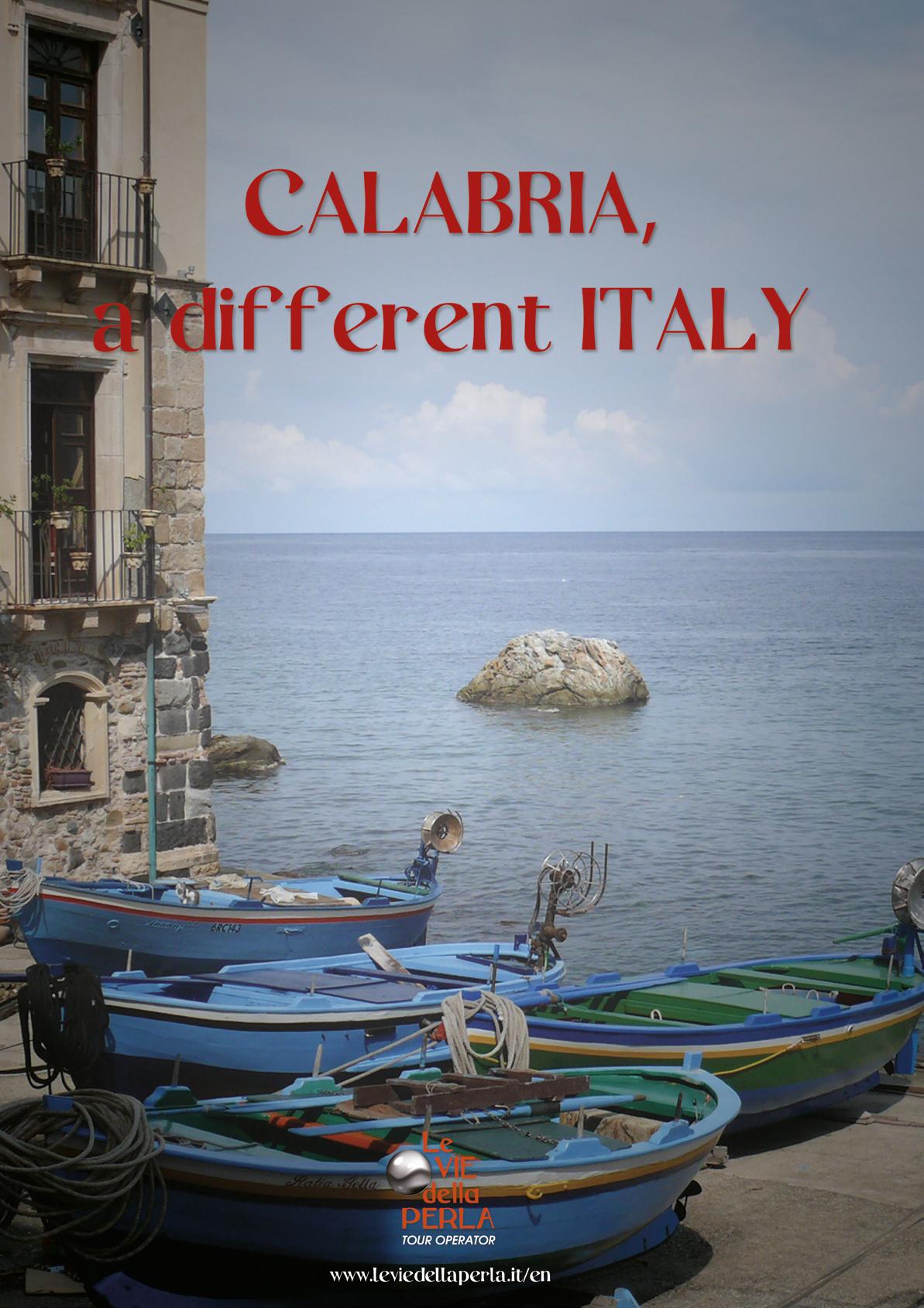
Calabria is a land famous mostly for the sea, but full of hidden spots with
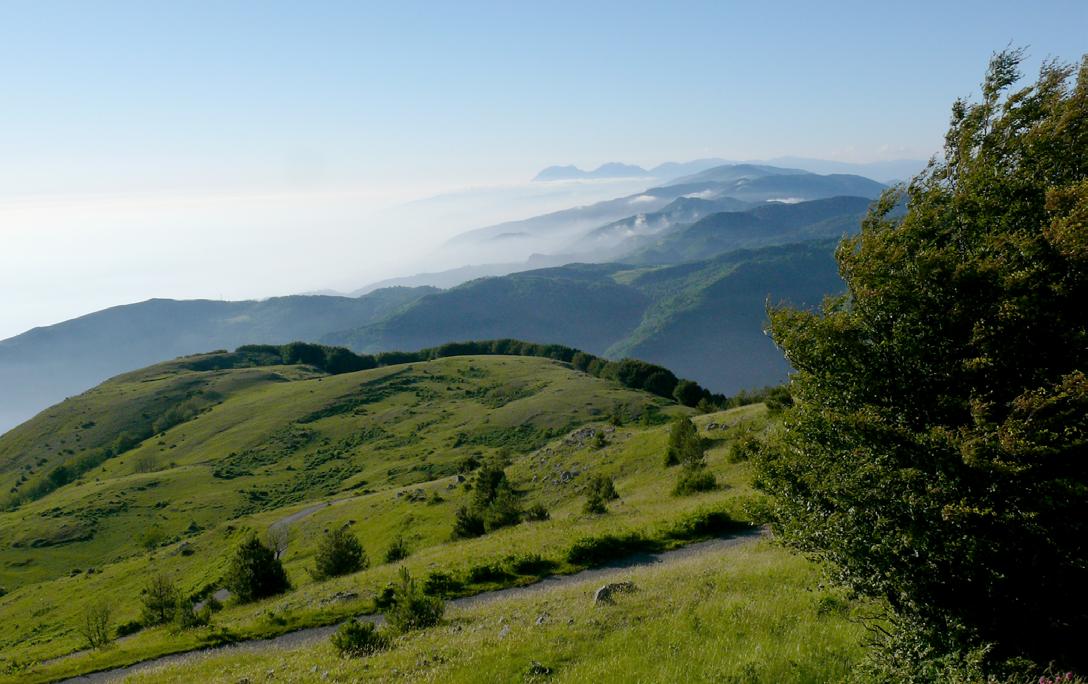
and legends about love and jealousy. Le Vie della Perla Tour Operator
most romantic places to discover.
Calabria has a green heart, which is reflected in the blue sea water surrounding it. From the top of its mountains, in the hinterland, you can glimpse outstanding panoramas extending as far as the Mediterranean Coastline – a unique sight that you can find only in this region of Italy, thanks to its long and thin shape. And at the narrowest point, in Tiriolo, known as the village between two seas, you can see both the Tyrrhenian and Ionian Seas.
There are several places in Calabria that can touch your heart and turn what might have started as a normal day into a romantic opportunity for spending time with your partner.
So, here are my recommendations for the most romantic places in Calabria using their breathtaking views or the legends linked to them as parameters.
What could be more romantic than enjoying the warm colors of a sunset seen from the top of Mount Cocuzzo, on the Paola Coastal Chain overlooking the Tyrrhenian Sea? You walk along a path through a dense pine forest, then continue to one of beech until reaching the eastern side of Mount Cocuzzo, an area called “Small Dolomites.” Here the vista opens out to display an entire stretch of the magnificent Paola Coastline, the Policastro Gulf and, if the sky is clear enough, the Aeolian Island and even Mount Etna.
Le Vie della Perla Tour Operator outstanding scenery guides us through theAnd what could be sweeter than kisses? After walking among the alleys of the Pizzo Calabro historic center, stop at the staircase in a side street of Via San Francesco called Vicolo dei Baci (Alley of Kisses) to seal your love. On the walls are pictures of some of the most famous kisses in movies, literature, and songs. Then, enjoy a delicious tartufo , a typical handmade chocolate ice cream in the main square, Piazza della Repubblica –the best way to finish a lovely day enjoying a romantic sunset behind Gioacchino Murat’s Castle.

Lo Scoglio della Regina (The Queen’s Rock) in Acquappesa is considered a good omen. According to legend, Queen Isabella of France, wife of King Edward II of England, saved herself by clinging to it during a storm. She wanted a son so much that she became pregnant after taking a bath in the warm sulfurous waters of the Luigiane Thermal Baths, in Acquappesa municipality.

If you love the world of fairy-tales, a visit to the Park of Lavender, between Campotenese and Morano Calabro, in Pollino National Park, is a must. Inside the
garden, delight in the smell and colors of medicinal herbs, especially the lavender, which blankets the entire park in violet. The best time to visit is in the afternoon, when the sunlight is warmer and the atmosphere becomes more magical. To finish the day, take a commemorative photo beneath the Tree of Love.
If you want to promise endless love, the best place is Lovers’ Cave, on the highest part of the small Greek village of Bova, on the southern border of region: it is said that the panorama is so extraordinary that you’ll never forget your promise, because it is inextricably linked with the memorable scenery. In fact, from there you can enjoy a breathtaking view overlooking the Aspromonte Mountains, the Fiumara dell’Amendolea (a river), the union of the Tyrrhenian and Ionian Seas, and the eastern coast of Sicily, where Mount Etna rises. A romantic walk in the alleys which wind among palaces and stone houses – well restored or still in restoration following the local style in this hamlet –evokes times long past.
For a romantic weekend break, I suggest staying in a bed and breakfast in
Chianalea, a fishing district in Scilla: here the houses are separated by small alleys and built directly on the rocks and in the sea water. In the evening, have dinner in a typical restaurant situated over the sea and surrounded by an enchanting atmosphere. Scilla, one of the most beautiful villages in Italy, is famous for the legend about Scylla (meaning “who tears apart”) and Charybdis (meaning “who sucks in”). According to Homer’s writing, in a display of jealousy, the witch Circe turned the beautiful nymph Scylla into a horrible monster who destroyed those who crossed the strait between Calabria and Sicily. Scilla is situated on a cliff, and the ships which passed during the storms through the strait were torn apart as they crashed against the rocks. According to Greek mythology, on the opposite shore of Sicily, the nymph Charybdis transformed into a sea monster who sucked up and expelled sea water, creating huge whirlpools. In fact, the main characteristic of this strait is the unpredictable strong currents. In order to bless your love, head to the Convent of the Capuchins dedicated to St. Daniel, not very far from the historic
contains
remains of St. Valentine, the patron saint of lovers. There are several stories linking St. Valentine to love. One of these is that he gave a dowry to a poor girl so that she could get married, thereby saving her from perdition – at one time, unmarried women were considered sinners. Another tells of a meeting between St. Valentine and two lovers who were arguing: to make peace between them, he gave them a rose recommending that they pay attention to the thorns and pray for eternal love. Then, my favorite part of the story: as soon as the lovers made peace and hugged each other, pairs of pigeons started to fly away. For this reason, we use piccioncini (literally small pigeons; lovebirds in English) to refer to couples.
Not very far from Belvedere Marittimo, take a cruise from San Nicola Arcella along Cedars Riviera, around Dino Island and in front of the outstanding Arco Magno, a natural arch carved by the sea.

Many other places deserve to be named, but the list is very long. Now you know: Calabria has so much love to give you.


 by Carla Trigilia | Photography by Carla Trigilia
by Carla Trigilia | Photography by Carla Trigilia
There are more than 2,000 reasons to visit the enchanting city of Syracuse, one of the most stunning places in Italy and, dare I say, in the whole world. Located in the southeast of Sicily, it was founded by the Greeks over 2000 years ago; yet with each year, it continues to acquire charm and beauty.
memorable fashion show inspired by the beauty of Sicilian women.
No wonder Dolce & Gabbana chose Syracuse. It is a magical place that welcomes its visitors in an enchanting atmosphere. Its historical center is like no other, in fact, Syracuse’s historical center lies on an island, Ortigia. Here, you can find the Duomo, the ancient Arethusa Spring, a beautiful lungomare (promenade), and the ancient Maniace Castle. On the mainland is the archaeological park, where you can find Greek and Roman ruins and the incredible Latomie, the infamous stone quarries that made Syracuse a fearsome rival in ancient times.
In the summer of 2022, Syracuse was also the undisputed protagonist of fashion internationally thanks to Dolce & Gabbana, who chose to celebrate the 10th anniversary of the launch of Alta Moda right here: “Syracuse is a special place for us,” Gabbana explained before the show, as reported by the National News. “It is in the southernmost part of Sicily, in front of Africa. I love the feeling, I love the mood, I love the stones, the colors, the people.” During the Alta Moda Fall 2022 Fashion Show, Dolce & Gabbana took over Piazza Duomo, where beautiful models walked the runway in epic looks against the backdrop of Syracuse's stunning cathedral. Red, black, and gold dresses of ruffles, lace, and religious iconography were the protagonists of a
If you want to live the myth, history, and culture of this city, and truly understand why Dolce & Gabbana chose it to stage their most important celebration, I - a born and raised Siracusana - recommend three gems that you cannot miss on a visit to the Island of Ortigia.
The Duomo is a wonderful example of Sicilian Baroque architecture: its facade has large columns and carvings that are so typical of the style that developed on the island – very different from the style you may find in other places. Inside, this enchanting cathedral will surprise you as it used to be a Greek temple dating back to 480 BC, and you will still find its columns. Building a Christian church on top of a pagan temple was not uncommon, but this is one of the most fascinating examples you can find in Italy.
Not far is the Arethusa Spring, which takes its name from a nymph from Greek mythology. In myth and legend, Arethusa was the object of desire of Alpheus, son of the Ocean, who pursued her obstinately. Desperate to get away, she managed to avoid him and made her way to the island of Ortigia, where she transformed into a well. Then, after changing into a river, Alpheus was able to find her by flowing beneath the Peloponnese all the way to Ortigia. The Arethusa Fountain is called by the locals La fontana delle papere (or just la fontana), as it is populated by ducks and, of course, fish. A common meeting place, it offers a beautiful view of the sea as well.

From the Arethusa Spring, you can walk along the lungomare up to the Maniace Castle. Located at the extreme southern tip of the island of Ortigia, it’s a 13thcentury castle built for the Emperor Frederick II. The castle is an important example of Swabian architecture, with a magnificent, vaulted central hall ( Sala Ipostila) and breathtaking sea views.


My best advice is to lose yourself in the narrow alleys of Ortigia, where you can soak up the real atmosphere of this magic island. Wandering will surely make you hungry, and the good news is that Ortigia is full of places where you can eat authentic and delicious Sicilian food. From cafes to restaurants and street food, Ortigia will not disappoint your taste buds.

Ancient Rome has always been a passion of mine. During visits to Italy, I have made it a point to see as many archeological sites as possible. On my last trip there, I decided to venture further afield to see what was on offer in other countries that the Romans had conquered during their period as the world’s superpower. Tunisia sounded promising.
I base myself at the tiny port of La Goulette, just outside Tunisia’s capital city of Tunis.
The room at my hotel has a balcony overlooking the glistening Mediterranean Sea. The beach is empty, bar for the local fishermen bringing in the daily catch. Cats skulk around the boats hoping to catch a morsel of disregarded fish. During my stay, I feast at local restaurants, where I enjoy an abundance of delicious seafood presented on overflowing plates – at rockbottom prices!
The first stop on this discovery tour is the ancient Roman ruins at Carthage, now

a suburb of Tunis. In Ancient Rome , the historian Nigel Rodgers explains how Carthage became the major port city for the North African provinces during Rome’s rule. It had all the features of a typical Roman city of its time, including a forum, basilica, and temples. But it is the incredible Antonine Baths that I have come to see. According to Rodgers, they were second only to the Caracalla Baths in Rome, in size, at that time. There is enough of the baths remaining to fuel the imagination, but its position on the shores of the Mediterranean Sea is what is truly stunning. Be prepared for an Instagramworthy moment of the ruins merging with the aquamarine hues of the sea. Next stop is the Bardo Museum, considered to house the best-preserved Roman mosaics outside of Italy. To get there, I take a short tram ride from
central Tunis. According to Rodgers, the settlers from Rome became quite wealthy during the period of Roman Carthage. Quite sumptuous villas were built in the towns that dotted throughout present-day Tunisia. Many artifacts have been taken from these villas for display at the Bardo. But it is the floor mosaics that stand out – they are simply stupendous. What they reveal is an incredible snapshot of all facets of daily Roman life. We can see examples of the foods grown and eaten, as well as popular leisure activities of the day. No self-respecting household would be seen without portraits of the gods, and many examples are displayed throughout the museum. We can also witness the sports Romans enjoyed watching – including grizzly examples of blood sports held in the arenas, matching gladiators against wild African animals.
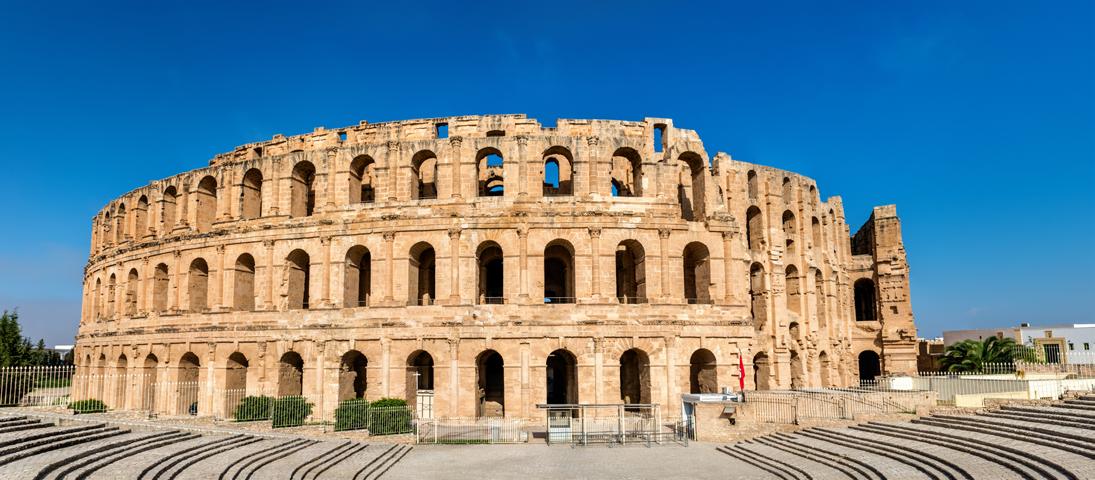
The final stop is to see an amphitheater where these battles took place. To see this site requires a few hours of travel by train from Tunis to the small market town of El Jem. From the train station, I am told it is a short walk to the center of town. Upon turning into the main street, I am stopped in my tracks by the sight in front of me – I am speechless. What lies ahead is a magnificent amphitheater. Massarra Dhahri, writing for the online Carthage Magazine in 2021, reiterates the magnitude of this UNESCO World Heritage site by claiming that it is only behind Rome’s Coliseum in size. It truly is a mesmerizing monument. I spend hours
walking throughout the amphitheater, which I have practically to myself. This is a different experience to battling with the crowds at the Coliseum in Rome. Also, I am able to walk onto the center of the arena and head below to the basement areas, where the gladiators would have nervously waited for their fate above. This unforgettable trip has come to an end. I decide to return back to Europe, as the ancient Romans would have done, by boat across the Mediterranean Sea. The first port of call is Palermo, in Sicily, where more Roman ruins wait for me to explore. But that is for another story!

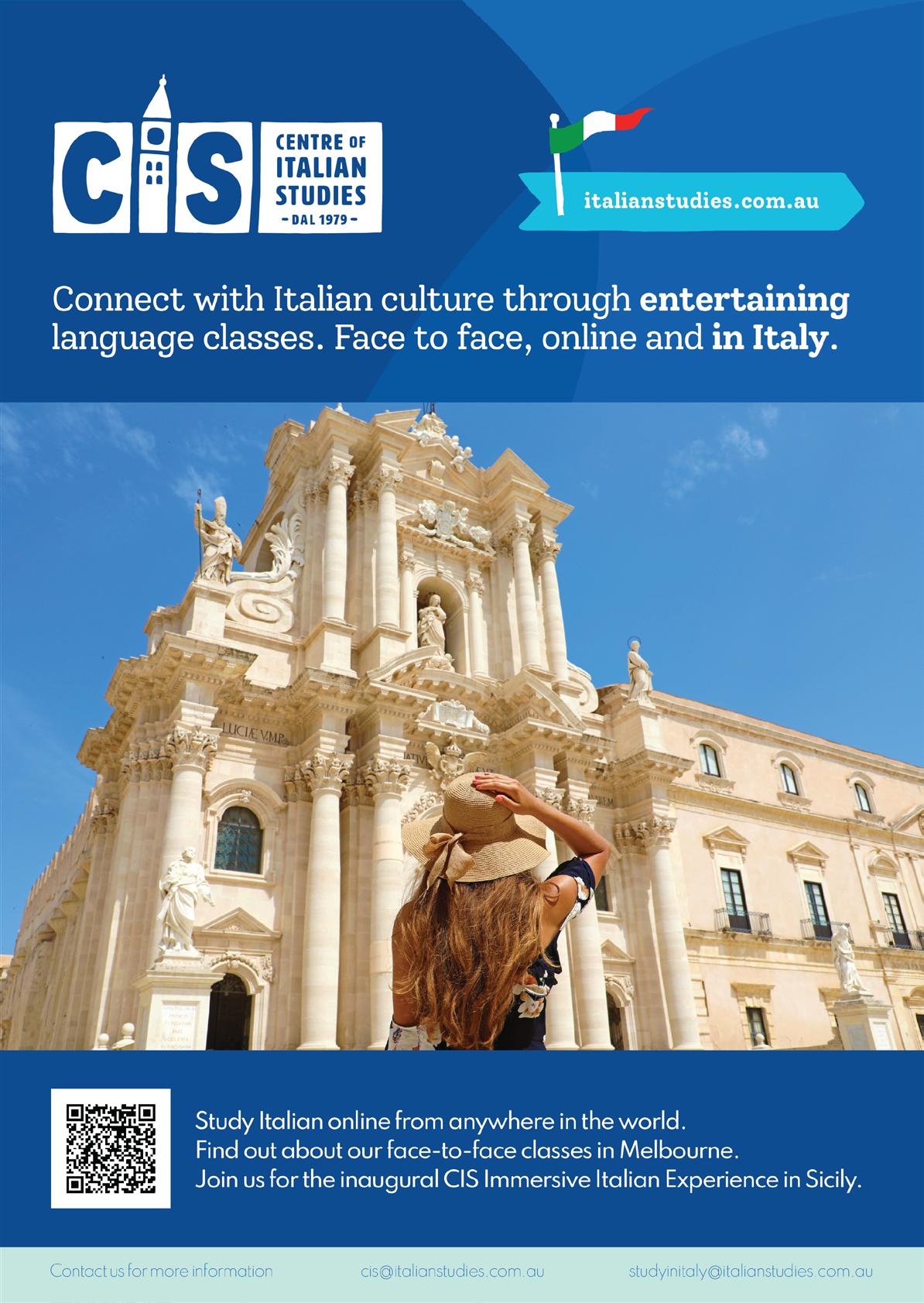

If Italian food is your favorite cuisine, you are probably one of the luckiest ones as a green, white, and red flag waves in almost every city, town, and even tiny village in the world. But where would an Italian really set foot in?
As aesthetic and cute a red and white checked tablecloth might be, this shouldn’t blind your judgment when choosing which restaurant will take you bite after bite closer to the bel paese All roads lead to Rome; however, not all restaurants do.

So, what should you look for in making this choice? Here are the sort of useful tips that you’ll want to tear the page out and put in your pocket for future reference.
Let’s start with the book cover of every restaurant: the menu. If you know the Italian language, a quick scan will already reveal a lot: gross mistakes like “pizza margarita,” “tagliatelle ai fungi,” and “foccacia” may be genuine typos or the sound of alarm bells. You could also find dishes like “fettuccine Alfredo” or “chicken carbonara” – walk right away as these dishes are unknown in Italy. One more thing about the menu: pesto is supposed to be a pasta sauce, not an ingredient. If you see it listed as an ingredient in more than 5 dishes, especially in second courses, it’s a big red flag.
A fine selection of antipasti is always a good sign, especially if they are regional specialities. Italians really love to nibble some salumi and formaggi while chatting and catching up with friends and family. The same goes for the wine list: being able to open a bottle coming from an Italian vineyard will immediately take your tastebuds on a journey.
So far, we’ve mentioned Italian restaurants as a general category, but it’s important to make a clear distinction between a classic restaurant and a pizzeria : the first one traditionally offers a great choice of
antipasti , primi , secondi , and dolci ; while a good pizzeria usually focuses on a wide selection of pizzas, with fewer pasta dishes, starters, and desserts. Pizza is a form of art and it’s usually prepared by a highly trained pizzaiolo, a specialized figure you’ll find only in a pizzeria
Bonus tip: Pizzas should feature maximum of 3 or 4 main ingredients to best showcase their freshness and deliciousness; there is no need to cover up great quality.
Approaching the end of your meal, ordering a good Italian Amaro or Grappa is a must! Together with the most known ones like Amaro Montenegro and Limoncello, look for local independent producers. Each geographical area has unique digestivi: ask the restaurant staff and have fun discovering new products.

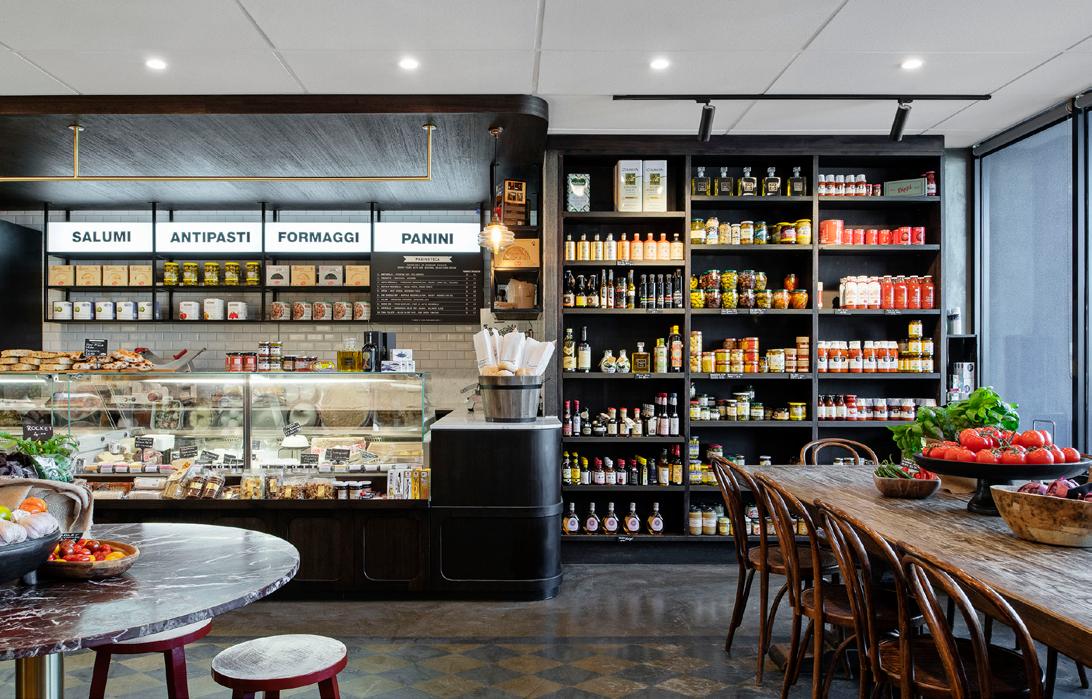
Your culinary journey could go even further… you might want to write this one down.
Some restaurants have an old-school delicatessen corner, which makes the experience even more authentic: seeing the products, being able to taste them at the restaurant, and taking them home afterwards to recreate the recipe is a wonderful opportunity. In the last few years, the food industry in Italy has been focusing in educating consumers, showing specifics and origins of the products. It’s what international companies like Slow Food and Eataly have been doing, and it’s reflected in the international panorama, including the Australian culinary scene.
It’s the example D.O.C. Gastronomia has set in Mornington, the exclusive seaside town just south of Melbourne. In this all-in-one Italian pizzeria, mozzarella bar, fresh produce store, and delicatessen, you can browse and stock up on all your favorite products, either locally sourced or imported straight from Italy, after tasting them in their welcoming environment.
Now that you have an extensive list, be mindful during your next night out and see what applies to your chosen restaurant. If it’s at least 8 out of 10, it’s Italian approved. No matter where you are in the world, a bite of the most delicious piatto della nonna could teleport you miles from home, imagining yourself sitting at a table facing the Mediterranean Sea, enveloped by a melodic song and a citrus scent. Or it could remind you how far you are and how much you’d want to jump on a plane to taste an authentic Italian meal. A delicious dream or the worst nightmare: choose wisely.

22 Main St, Mornington, VIC 3931
Open 7 days a week, from 9:30 until late| Phone: (03) 5977 0988 | https://docgroup.net/
Following the contemporary trend, the mission is shown in their name: D.O.C. is, in fact, the abbreviation of an Italian appellation Denominazione di Origine Controllata , meaning “of controlled origin denomination” and used to identify products with specific characteristics, enhancing the biodiversity of Italian food and using fresh, seasonal, local ingredients. This is why you’ll find not only San Daniele prosciutto, Pantelleria capers, Sardinian anchovies but also organic fruits and vegetables sourced from local farms, and cheeses and cold cuts crafted by local artisans in Victoria. docpizza doc_gastronomia

Roses campaign and which advocates for sustainable and responsible lifestyles. In her presidential role, she is guided by a glocal vision and represents the south of Italy and what that region teaches the rest of Europe and the world at large in terms of approaches to food and healthy eating habits and the value of coming together as a collective, enjoying a slowing down, and getting back to basics as well as a focus on a “less” that is, in reality, “more.”
Of Tuscan origin, Barbara Nappini is the first woman to have been elected president of Slow Food Italy – at the organization’s Tenth National Congress in Genoa. Following in the footsteps of Carlo Petrini, the founder of the International Slow Food movement, Nappini is likewise founder of the association Il Grano e le Rose di Arezzo (in 2010) – an organization which is partly inspired by the Bread and

With a mindset set on “a world in which all people can access and enjoy food that is good for them, good for those who grow it and good for the planet” and an approach “based on a concept of food that is defined by three interconnected principles: good, clean, and fair,” in Slow Food, storytelling also becomes an important method to spread the word (“What is not told does not exist. Tell the stories, and they exist!”). Nappini’s own story is one of hope and aspirations, trial and error, and ultimate successes. She has boldly ventured into different chapters and embarked on new life paths, and talks of life’s many twists and turns, explaining that she “actually had two lives.” Her first decisive chapter was the period until 2010 when she lived in an international group or community. While it was “very challenging, living in an international context” was “fun and comfortable.”
With a background in the Florentine fashion industry, Nappini eventually “felt uncomfortable with this comfort.” Her second life began in 2010 when she continued the research journey that she had already initiated – within herself.
“We need to reflect on the way we live and the way we eat – and the south of the world is importantly sitting at the table of the decision-makers.”
Aware of the impact her own lifestyle choices thus far had had on the planet and the ecosystem, she needed a change and to engage in new thoughts and endeavors. She left Florence and moved to a stone house on top of a hill with 3 hectares of land around it. Set on working the land, she and her family started a small organic farm with the intention of becoming farmers “as absolute beginners.” While this proved hard to sustain and they faced difficulties relating to, for example, generational change, mechanization, and crop maintenance on hilly terraces, Nappini acknowledges how important it was not to be successful and that it was a good learning experience. In 2012, she first connected with the Slow Food Association in Italy and became a member and activist; likewise engaging in a spiritual awakening. Her personal research had become collective, and from the concrete focus on bread and grain as main staple foods, Nappini quickly embraced the Slow Food movement, which was similar in approach. Her background in farming provided invaluable insights and has helped her navigate her important role. She promotes food as a “concrete thing” and highlights the connection between food and “all the rest of human life” –including “science, identity, and dignity of knowledge, the environment, religion, philosophy.” She looks at food and crop cultivation, access to and distribution of resources from a holistic point of view. With regard to Italy and the Mediterranean culture, southern Europeans are natural survivors who remain resilient, resourceful, and ultimately hopeful. Nappini agrees that countries like Italy show the way to healthier collective eating and positive social interaction. She praises Carlo
Petrini’s overall vision and deems him “so farsighted in the 1980s.” His movement came as a reaction to the fast-food model that was “not only a restaurant model but a cultural model” and that triggered the fast food-fast life conundrum. Nappini elaborates:
You change the time of human life into the time of industry. There are no more shared meals; you must perform, and you must be on the run. You cannot lose time on buying, choosing, preparing, and sharing food. What was impactful to me was this vision –so clear.
With reference to the COVID-19 pandemic, it clearly and violently revealed the flaws in systems which were “not working. At the moment when we increasingly needed to be safe, it expressed all its limits.” Quoting from David Quammen’s 2012 book Spillover: Animal Infections and the Next Human Pandemic, she says, “Viruses are necessary and natural.

It is not viruses that make our societies vulnerable, but our activities.” According to Nappini, we need to honestly say things as they are and not as we would like them to be: “There is a need to reequilibrate and give back balance to all the anthropic activities that destroy our natural environment. The core thing is about the way we produce and the way we consume.”
In Slow Food, the focus is on the transition from animal consumption to a plant- and protein-based diet. A scientifically attuned Nappini says:
Hunger on the planet is not a matter of scarcity but it is a matter of poverty … And we know from the Food and Agriculture statistical data that we are producing so much more food than the number of people. We waste one third of the food produced and could feed four times the people without access.
She adds: We do not have a problem of maximizing production, but we have a problem of distribution and access in terms of money. People who starve do so because they are
poor, not because there is no food. It is a matter of distribution – it is about the unfairness of our systems.
At the Slow Food 8th International Congress in Pollenzo in July this year, then-departing President Petrini declared: There’s a need for the direction, creativity and intuition of a new team capable of interpreting our present situation, outlining a trajectory and achieving our future goals, which at their core, remain the same: to guarantee good, clean and fair food for all.
Are we on track to achieving some of these goals? Nappini emphasizes:
We are facing an urgency and don’t have more time. Food today is a matter of human rights. It is very clear to me. At the same time, I am very optimistic, and the speech I delivered on my election day was called “Faith and Hope,” I was quoting Goethe. Both are necessary but they are not blind optimism.
In her view, we need to be brave enough to explore unknown paths, embrace new thoughts and a new language, and with that a new way of thinking – as long as it leads us to the truth.
In closing, Nappini summarises her attitude to life and the movement, with “slow food radicals” leading the way – and her words become universal truths to draw from: “It is just about doing what is fair and right any time –in small decision like in big ones. I could never be competitive or try to win someone else.” She promotes the Terramadre Salone del Gusto 2022, with an outlook on healthy eating and food as a generator for positive social change and interaction, and with a theme of “regeneration,” as the next important key event and says it has to become unforgettable.

To make our famous “Giardiniera in oil” we use the noblest parts of fresh vegetables. However, we don’t throw anything away! With all the so-called “waste” of the vegetables, we prepare a delicious soup that honors the fifth vegetable. And this is how the carrot peels, the leathery parts of the fennel, the cores of the cauliflower, and the bottom of the celery become the protagonists!

Leaves, peels, vegetable cores
Extra virgin olive oil
1 leek (reserve a portion for garnish)
Coarse salt and black pepper
Stale bread (for croutons)
Fry one leek in plenty of extra virgin olive oil, and keep a small part to fry later and use as a final garnish. Coarsely chop the vegetable craps and add them to the leek that is frying. Use everything you have, for example, the celery base and its fragrant leaves, the external and leathery parts of the fennel and its leaves, the skin of the carrots, the ribs, and the cores of the cauliflower.
Add water and leave to simmer for a long time until the vegetables are soft. While cooking, add Cervia coarse salt and, when the vegetables are cooked, blend to obtain the cream.
BUON APPETITO!

Garfish rolls


This dish is a critique of the standardization of cultures and the globalization of taste. “Casa & Putìa is a cultural project deeply related to that of the Slow Food Cook’s Alliance, to which, for this reason, we have joined since its foundation, working directly with many producers, artisans, and farmers, trying to give strength and support for local consumption.”
16 ribs
100 gr of fresh crumb of timilia (Ark of Taste)
100 gr semi-seasoned Maiorchino cheese (Slow Food presidium)
Minuta oil to taste (Slow Food presidium)
Sea salt of Trapani to taste (Slow Food presidium)
Chopped parsley
Juice of an Interdonato lemon from Messina (ark of taste)
1 Cipudda Partannisa (Partanna red onion – Ark of Taste)
Red wine vinegar
Eviscerate the costardelle, open them carefully, rinse them gently and dry them with paper towels.
In a baking dish, add breadcrumbs, salt, pepper, chopped parsley, and add as much oil as needed to soften the breadcrumbs.
Now place the crumb mixture on each sauté, roll up and block with a toothpick.
Arrange the rolls in an ovenproof dish placed on parchment paper, add a drizzle of oil, bake at 180 ° C for about 10 minutes.
Cut the onion into strips and put them to marinate in the vinegar. Serve the rolls accompanied by the marinated onion. Add a drizzle of oil and a pinch of salt.


Confapi Sicilia is promoting initiatives of human capital and economic development among municipalities in Sicily. Dhebora Mirabelli spoke to Segmento about their latest project, Pensiamo a sud.
human capital and economic development among municipalities in Sicily.
How is Sicily placed to become a hub of economic development and innovation?
Confapi Sicilia views the agricultural industry as a key asset for the development of Sicily.
Dhebora Mirabelli is an entrepreneur, export manager, innovation expert, and lawyer. She is the first woman president of Confederazione italiana della piccola e media industria privata (Confapi) Sicilia. Deborah has always invested in her training by acquiring multidisciplinary specializations in public and private management. In recent years, she has collaborated on numerous ethical and social innovation projects, dealing with design, technical assistance, and supervision, in particular for the allocation of funding resources. She has more than 10 years of experience in the management and control of European funds and public funds, support activities for the Ministry of the Interior, the Ministry of Economy and Finance, the Ministry of Labor and Economic Development as well as the network of public investment evaluation units. Segmento spoke to Dhebora about how Confapi Sicilia’s initiatives promote
Two other strengths of the island are tourism and culture, and the food and wine supply chains. If these are properly exploited, there is potential for development with exponential growth and obvious synergies can be created. Although there is already a strong connection between various industries on the island, it is still important to continue investing in some key areas, such as communication, innovation, and digitization. In recent decades, external factors, such as globalization and rapid technological development, have led to sudden increase in the value associated with highly innovative digital capital.
Confapi Sicilia cannot ignore the need to promote digital literacy and technological innovation for the benefit of those in need of economic independence: young entrepreneurs, women, victims of abuse and violence, and, in general, all those seeking employment. The added value of our current project is the implementation of public services that facilitate the development of human capital through technology and highly innovative and creative digital and territorial marketing.”
In 2021, Confapi Sicilia internally also established the Committee for Internationalization and Foreign
 Dhebora Mirabelli
Dhebora Mirabelli
Taxation, a new coordination and support service to promote Made in Sicily internationally that is responsible for coordinating the work of ambassadors and promoting the participation of Sicilian start-ups in international events to encourage networking with foreign investors. With the enactment of the 2022 budget law, Confapi Sicilia officially became part of the steering committee for internationalization. This international body is co-chaired by the Ministries of Foreign Affairs and International Cooperation and Economic Development, it defines the strategic guidelines each year, and actions the promotion and internationalization of the production system.
What is an example of collaboration and project development and synergy between Confapi Sicilia and small municipalities in Sicily?
The synergy between tourism, food and wine, the environment and territory represents a key factor for our economy, an element of strength we must focus on so that sustainable and lasting economic growth can be nurtured for the south and for the country as a whole in order to increase exports and the internationalization of Made in Sicily products and excellence. An interesting project is the one carried out by the municipality of Mussomeli. Confapi Sicilia has promoted the Pensiamo a Sud initiative. Mussomeli and other Sicilian villages have espoused Confapi Sicilia 's strategy: let's invest in productive districts to restore value to Made in Sicily. The agreement between the municipal

administration and Confapi Sicilia is aimed at promoting the development of productive districts in the cultural tourism and agribusiness sectors. This is through the commitment of Confapi Sicilia to transform €1 properties (the municipality has focused on the rebirth of the village, starting with the inhabitants and local businesses and ending with tourism and policies to attract foreign investment and capital) into productive economic reality. All this is thanks to its own production chains, both local and national and international, and creating real productive interconnections both for all those young entrepreneurs who do not want to leave Sicily to develop their ideas but also to give a physical space to those who want to create, expand, or relocate their business activities in Sicily.

What exactly is the Pensiamo a Sud project, and why is it aimed at supporting young Sicilian start-ups?


It is the first digital business accelerator of the agri-food and cultural tourism supply chains with young people in mind. With Pensiamo a Sud, Confapi Sicilia created a business incubator for people who desire to stay in the south and start their own companies: a unique approach that matches top market experts with the ideas of young men and women; a network ready to instantly offer online advice, guidance, and suggestions.
It is structured in different offices to support people in different areas (export office, intellectual property office, marketing office among others). Through this project, Confapi Sicilia collects business ideas to turn them into business projects. It provides consulting and training services on digital strategy, access to credit, subsidized finance, territorial and digital marketing, intellectual property protection, digital export and business internationalization, legal and financial consulting, investment appraisal, business plan drafting and evaluation:
• Pensiamo a Sud allows people to have all the solutions they need at their fingertips. In fact, it contains not only digital manuals and video tutorials but also a virtual assistant for real-time guidance to the best content according to user needs, as well as a complete contact list of professionals.
• Progettiamo a Sud will allow users to quickly and efficiently submit business ideas through an app by answering targeted questions developed by our experts. The system will provide an immediate response on refining the idea and steps to bring it to completion.
• Advisory Sicily Influencer represents a young and creative communication strategy that targets young people. In this way, topics such as tax advice, internationalization, and legal issues are user-friendly and within everyone's reach.

• Safety card with interactive QR code - SOS VIOLENCE gives users the ability to report harassment and violence in the workplace and look for new jobs at ethical and safe companies by scanning the QR code. In addition, users will be able to apply for open job positions from Sicilian companies that have joined the European Digital Observatory project against harassment and violence in the workplace.
• CRM is the beating heart of the team's and experts' activity digitized for coordination with other plan projects.
• Chatbots will provide guidance for finding the right professionals and sectors in more than 10 topics available on Pensiamo a Sud.
 by Natalie Di Pasquale | Images provided by
De Domenico OAM
by Natalie Di Pasquale | Images provided by
De Domenico OAM
Antonio “Tony” De Domenico, born to Italian migrants from southern Italy, was just 4 years old when he migrated from Alexandria, Egypt, to Melbourne, Australia. “You have two ears and one mouth; as long as they work proportionally, you’ll do well.” Tony shares treasured wisdom from his late father, a jeweller who was interned during World War II. As a migrant who experienced discrimination in the 1960s, Tony instinctively became a “fighter” – the foundation of the resilient and empathetic nature he embodies today.
Starting off as a journalist, he quickly shifted to a boisterous career in politics. In spite of high hopes, he lost the 1977 Victorian state elections by a narrow margin. He clearly recalls the headline in Melbourne’s Toorak Times “What’s this Wog doing in Toorak?” and negative comments such as “Why doesn’t he stand on the soap box in Footscray for the Liberals?”
The anti-migrant sentiments of the 1980s and 1990s hung in the air. He described his political career as “brutal” – a doubleedged sword in this formula of success. Gracefully knocking back criticism, Tony managed to fully assimilate into Australian politics: he arrived in Canberra in 1981, he was elected to the Australian Capital Territory Legislative Assembly in 1992, and spent the next 20 years in Canberra, where he became the first Italian leader in the Australian Capital Territory
Government; then president of the Chamber of Commerce, member of the Australian Capital Territory Legislative Assembly; and subsequently the deputy chief minister.
Tony’s career highlight was his secondment as trade commissioner in Milan in the early 2000s for the Australian Trade and Investment Commission. It was Tony who signed off on the Melbourne-Milan sister city relationship, which endures to this day. Thanks to a short sommelier course and his ability to speak Italian fluently, he managed to do the impossible and sell Australian wine to the Italian
Journalist, politician, chairman, industry leader, Order of Australia Member and nonno… the former deputy chief minister of the Australian Capital Territory and chairman of Bertocchi Smallgoods has been in the business for over 50 years! Tony Tony De Domenico and his grandson Xaviermarket. Tony easily bypassed any of the cultural barriers that Italian-Australians might feel when visiting their homeland; in fact, he forged connections that went beyond business negotiations. This took him all around Italy, exploring artigianale production houses and, most importantly, meeting his future wife. This vivid and romantic time abroad had him wining and dining at Italy’s finest osterie while rubbing shoulders with Italian fashion icons such as Giorgio Armani.
Tony aims to nurture the trade relationship with Italy and Australia in his position as life member at the Italian Chamber of Commerce. He served as president alongside friend and colleague Frank Gambera as vice president, for 10 years. Gambera boasts of Tony’s innovative strategy of self-funded activities which saved the chamber and its growth over the years. Fast forward to today, the chamber works closely with the Ambassador of Italy
in Canberra on the import and export relationship between the two countries in major industries such as medicine, high technology machineries, and defence technology.

“Why kill with poison when you can use honey?” is another proverb guiding Tony’s business approach. Despite his renowned reputation in chairing numerous federal government and private boards, in 2018, Tony woke to the front page of Melbourne’s newspaper The Age with its headline “Property Guru with Mafia Link.” In fear that 45 years of community work would be flushed in an instant, Tony took legal action against The Age, successfully resulting in remedies but most importantly an apology to clear his name. There is a silver lining to this story – In the same year, he was awarded the Order of Australia medal for his contributions to urban planning, research, and development.
Now at Bertocchi Smallgoods, he boasts about how it is still a family-run business that continually seeks to improve their products and quality. With their connection to Beretta (the biggest salumeria in the world) and Parmigiano Reggiano, Tony is passionate about the brand. As a board member for 12 years, chairman for 6 years at the Italian Chamber of Commerce and Industry in Australia – Melbourne, and inaugural chair of the Melbourne Italian Festa, he remains actively involved with projects he is passionate about. It is clear he holds tightly to the Italian culture and has been an iconic contribution to the migration story of Australia. Of all the titles he holds, unsurprisingly however, his biggest achievement is becoming a nonno!
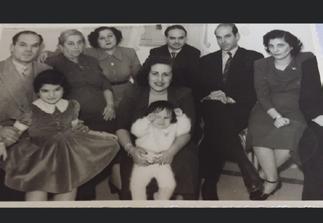 Tony (center) and his family in Alexandria, Egypt
Tony (center) and his family in Alexandria, Egypt


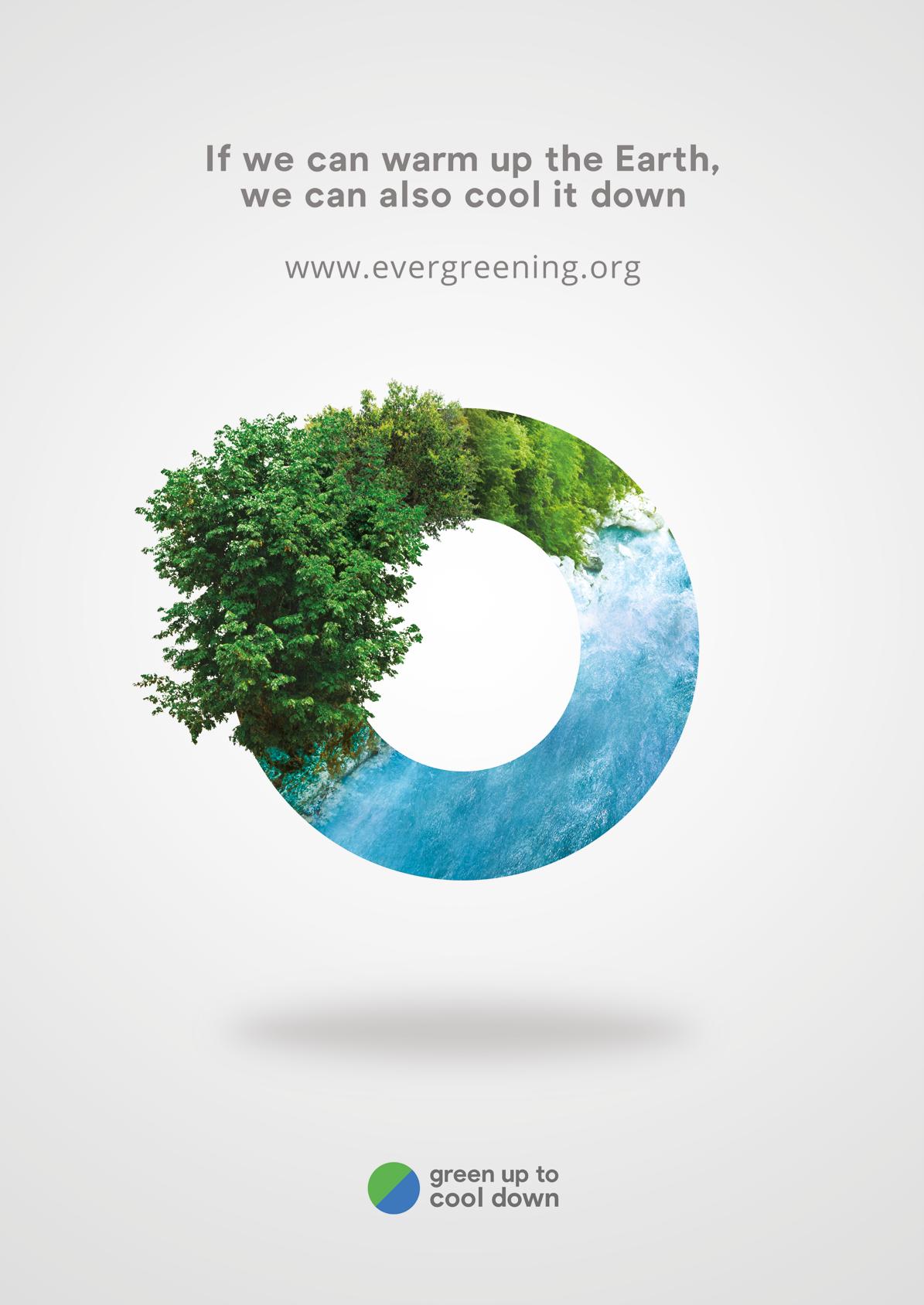
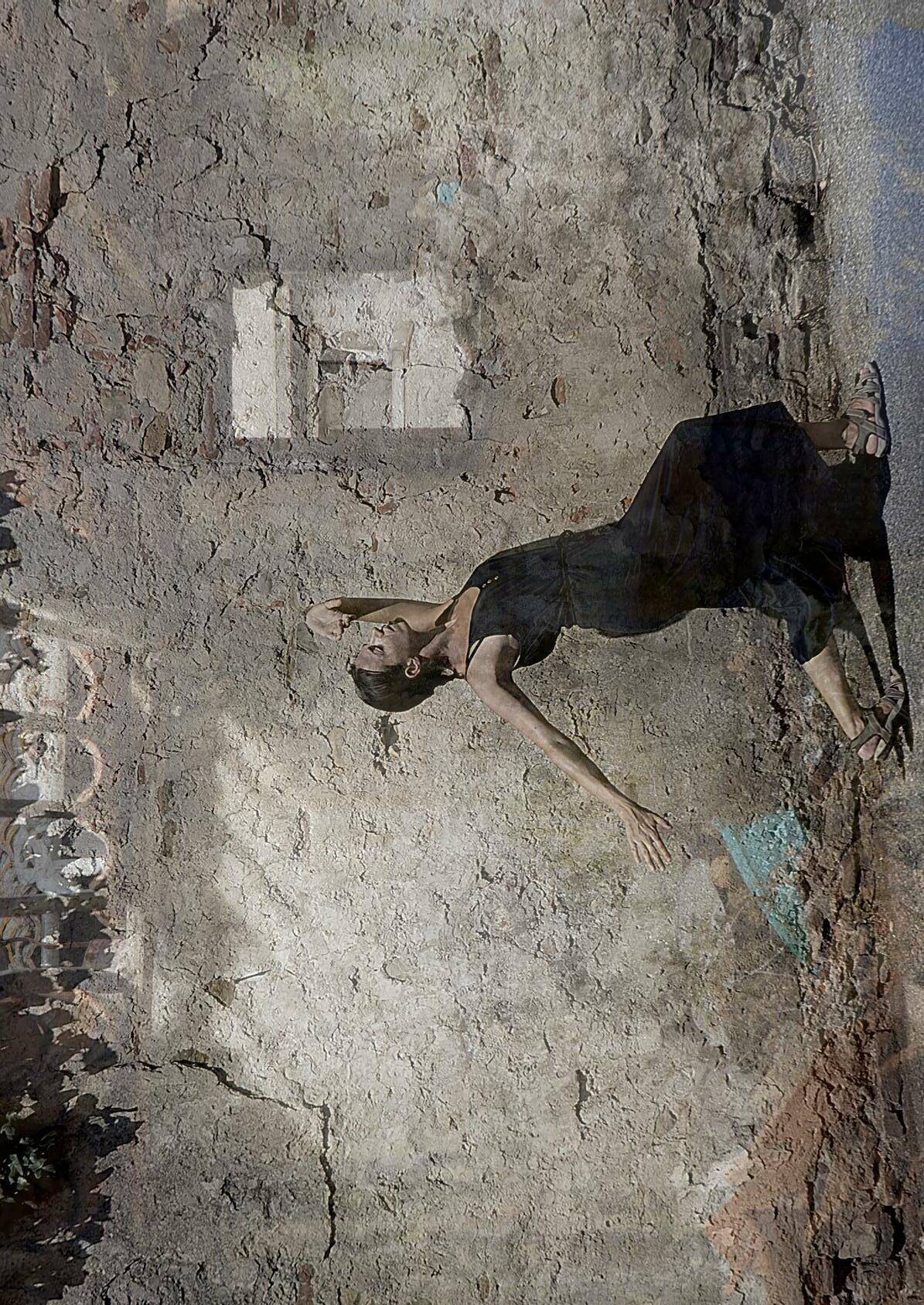
by
War brings destruction. Death. Pain. Pride. Enrichment of some, impoverishment of many. Yet “the Light Shines in the Darkness,” writes Leo Tolstoy, author of the novel that inspired this issue of Segmento.
In the cover image of this issue of Segmento , the light filters through the bars of the window, blinding the woman. Defending her eyes from the glare is a gesture of the hand – an immediate response of the body to the unexpected. The switch from a positive image to a negative image draws us to a stark, internal contemplation of the human condition. Our fragility in the face of events beyond our control. The wars that are taking place today directly impact the millions being displaced from their homelands or forced to endure extreme hardship while living among dilapidated buildings – and indirectly impact us all. Will we raise our hand to protect our sight?
The photographer Renato Colangelo describes how he felt during the shooting of these powerfully evocative images: Exploring my ancestral homeland, I encountered dormant secrets and halfforgotten ghosts. I hear their memories, see their faces at times in my dreams, and feel their deeds relentlessly pushed around by every breath of wind in every corner, filling the space around us in a ceaseless, disorderly movement. Slowly, quietly, the disharmonious beauty unfolds and dissonant elements are nurtured into relationships.

Renato was inspired by the traditional and ritualistic dance and music of Southern Italy as a sign of forging peace: The concept behind this work stems from a recent engagement with my ancestral homeland and the exploration of how our ancestors formed relationships with their village. In turn, the work reflects their daily sacrifices and displacement by portraying gestures and repetitive movements.
When working on this project, in fact, Renato was inspired by the late Italian photographer Luigi Ghirri (1988, pp. 87–94 ) and his essay A Gate onto the River:
Everything remains on the surface, we envisioned the land as a thin sheet of steel, which lets nothing through: thus memories, faces, deeds and people move around and do not sink and disappear.

The concepts of war and peace, life and death, positive and negative are all present in this photographic project that was born out of a need to retrieve the human connection to the past:
This exploration via body, gesture, and shadow as metaphors for lived experiences is intimately connected with the core needs of human existence. Using patterned ways of moving and thinking, I’ve discovered naturally evocative movements that connect with archetypes and myths. Melancholy emerges from awareness that life will always be haunted by memories of the past, while awaiting the new or different is an interval always marked by tedium.
The cover image was photographed in Verbicaro (a small mountain town in the province of Cosenza, Calabria). Rosa and I have a deep connection to this town, which stems from when we lived there almost 20 years ago. On this occasion, our objective was to honor the dilapidated part of town with offerings of gestural and repetitive movements. The images came to me like in a dream.

 Renato Colangelo
Renato Colangelo


Friday evenings with Ilaria Crociani and Mirko Guerrini.
Songwriters behind the scenes: Giorgio Gaber, Ivan Fossati, Cristina Donà (Special guest: Ryan Griffith) 2 December, 6.30 p.m. – 8 p.m. Free events. Registration essential: https://www.coasit.com.au/ 189-199 Faraday St, Carlton VIC 3053

SICILIAN NIGHT DINNER DANCE 2022
Annual dinner dance celebrating Sicilian Night & Christmas Breakup with an authentic members lounge menu curated at the Whitehorse Function Centre

Saturday, 3 December 2022 6.30 p.m. – 11.59 p.m. AEDT Whitehorse Function Centre, 298–336 Burwood Hwy, Burwood East VIC 3151
Tickets for sale at: https://www.eventbrite.com.au
PASOLINI: A CENTENARY RETROSPECTIVE

A series of screenings to celebrate the centenary of Pasolini’s birth. Screening every Sunday from 16 October to 11 December.
Melbourne
DANTE'S DIVINE COMEDY 2022INFERNO AND PURGATORIO
10 weeks reading course in English presented by Dr Simon West.
Rescheduled: End 2022 – beginning 2023 Information: dante.alighieri.melbourne@gmail.com
In association with Istituto Italiano di Cultura Sydney, Cinema Reborn, Cineteca Bologna and Fare Cinema 2022
Full program and tickets at: https://www.ritzcinemas.com.au
Melbourne

POLITICA, POTERE E PRINCIPI: IL PRINCIPE DI MACHIAVELLI
Course in Italian presented by Dante Alighieri Giovani, with Nicholas Sgro-Traikovski
Starting early 2023
Information: dante.alighieri.melbourne@gmail.com
1 December 2022 –La banda degli onesti (1956)
Tuart College, Block A Room 120 upstairs, 105 Banksia Street, Tuart Hill, WA 6060 Book your ticket at https://www.eventbrite.com.au

ICCI QLD & NT CHRISTMAS LUNCH AND BUSINESS
ICCI QLD & NT Christmas Business Networking Lunch with the Lord Mayor of Brisbane, the Right Honourable Cr Adrian Schrinner, and Business Awards
1 December 2022
11.45 a.m. – 2.30 p.m. AEST Tickets for sale at: https://www.eventbrite.com.au

Co.As.It. Community Services has a reputation for hosting unmissable events such as their annual International Women’s Day High Tea. Expanding to welcome our wonderful growing community, the 2023 event will be held at The Greek Club in West End. With the enigmatic Kim Skubris at the helm, it will be yet another fun-filled celebration including a fashion parade, fabulous food, prizes and much, much more. Rejoice in the stunning theme of “Sicily” – the event is sure to capture the imagination of all who attend.
We look forward to welcoming you to this event on 11 March 2023.
Direct from Italy, the Italian tenors Evans Tonon, Sabino Gaita, and Luca Sala will be returning in 2022 for their fourth Australia tour. A worldwide popopera phenomenon, their show cannot be missed by those who love the arias of Puccini and Verdi, the Neapolitan songs of Caruso and Mario Merola, and the hits of Sanremo.
9 December 2022


6.30 p.m. for a 7.00 p.m. start ANFE – Wyandra St, Teneriffe QLD Book ASAP 0401 927 967 or info@dante-alighieri.com.au

Previous events have SOLD OUT weeks in advance.
Don’t miss out – register your interest: https://www.coasit.asn.au
This series of screenings is dedicated to some of the most significant contemporary cultural and social aspects of Italian life as well as representative figures of Italian cinema.
19 October at 7 p.m: The Vice of Hope
16 November at 7 p.m: Tigers
Tickets for sale at http://www.palacecinemas.com.au/
The project revolves around “plogging” – an activity that consists of collecting waste while running (or walking). Anyone can participate in the event through the Pacer app, where the Run with Europe group is located. Within the group, they can upload photos of the litter collected, comment on the posts of other participants, or just be active and have fun in the community of like-minded ploggers. Among the EUNIC Japan countries involved, there is also Italy.
Running until 31 December 2022
5–11 January 2023
Waiheke Cinemas
127–129 Oceanview Rd. Oneroa, Auckland 1081
Tel: 09 372 4240 URL: https://waihekecinema.co.nz

Join us for our Italian Christmas Market and stock up on all your Italian gifts, panettone, pandoro, fine foods, decorations and much more.
Free entry
17 December, 10 a.m. – 3 p.m.
Freemans Bay Community Centre
Notte in Galleria will celebrate the uniqueness of Italian products through the exquisite combination of product aesthetics and quality. In the year of the celebrations for the China-Italy Year of Culture and Tourism, this special night will also be a discovery of our rich artistic heritage that nourishes this aesthetic taste.
6 December 2022
Park Hyatt Beijing


The exhibition Futurist Universe presents around 258 pieces of paintings, drawings, sculptures, graphic design, photography, collage, books, and industrial design made by Futurist artists in an incredible history. Visitors will encounter artworks created by Umberto Boccioni, Giacomo Balla, Fortunato Depero, Antonio Sant'Elia, Luigi Russolo, THAYAHT, Bruno Munari, Virgilio Marchi and many other presentative futurism artists.
Running until 4 December 2022 from Tuesday to Sunday 9 a.m. – 5 p.m.
3rd Floor Exhibition Hall, Tsinghua University Art Museum
The conference will offer the opportunity for a concrete dialogue and exchange between the Italian and the Chinese business communities on topics of shared interest. The aim is to highlight the value of the Made in Italy, while discussing business opportunities, investments and challenges for Italian companies in China.
5–6 December 2022
More information: bj.activities@cameraitacina.com
More information: bj.activities@cameraitacina.com
Galleria Continua, a prestigious name in the international contemporary art scene, founded in 1990 in the medieval town of San Gimignano by Mario Cristiani, Lorenzo Fiaschi, and Maurizio Rigillo. It now boasts 8 offices around the world; and in its space in Beijing, it focuses on the concepts of identity and mirroring, in an attempt to merge both elements.
Free entry
Running until 20 January 2023
Yishu District 798 No.2 Jiuxianqiao Rd, Beijing


Cari lettori, I am Ambra Dalmasso, and my adventure as part of the Segmento team began in 2021 as a writer, and today I also manage its social media presence. I grew up in a little village in Piemonte, a beautiful corner of Italy with a 360-degree view of the Alps. As much as I love Italy, I’ve always been fascinated by the idea of exploring new countries, cultures, languages, foods, traditions. Since I was a kid, I’ve always dreamed of traveling the world, and I’m proud to say my dream became reality.

After graduating in foreign languages and literature, with a Master in Editing & Journalism, I left Italy in 2016 for a 6-month trip to Southeast Asia. Little did I know that it was only the beginning. Since then, together with my partner, I have traveled to more than 50 countries and lived in the United Kingdom, United States of America, Vietnam, and Australia. Nurturing our passion for writing and photography, we founded A Million Travels, a website written both in Italian and English with related social media pages, on which we share stories and inspire people with photos and videos from all over the world. A project that was born with the idea of staying in touch with family and friends soon became a proper business.
Over the years, I worked as Italian and English teacher, book editor, writer, photographer, videographer, and social media manager. Today, I’m a full-time digital nomad, always on the move, capturing new stories. I strongly believe pushing ourselves out of our comfort zone and opening up to different cultures makes us better persons.
Where to next? The whole world, one country at the time, always taking the Segmento readers with me!
La pelle in cui abito by Kader Diabate and Giancarlo Visitilli, Laterza

Kader is a 15-year-old boy from the Ivory Coast. He wishes to be free and live a better life. He crosses Libya and braves the waters of the Mediterranean Sea on a boat to reach the Italian shore. Today, Kader is a human rights activist always on the front lines defending the weakest.
We recommend it because …
Through the eyes of a young Ivorian boy, we discover the region of Puglia and its welcoming people.
Discover countries that no longer exist, such as the Republic of Venice, through the Extinguished Countries podcast, available in English, Italian, and French. Free to listen online or to download.
We recommend it because …
A constant of history, often marked by war and peace, is that borders shift and countries are remade and renamed. The first eight episodes are about eight places in the former Serenissima. Can you guess which ones?

Extinguished Countries podcast available at https://extinguishedcountries.com/ Noi credevamo by Mario Martone

Set during the historical period of the Italian Risorgimento, the film follows the stories of three young men who join the association Giovine Italia, led by Giuseppe Mazzini. It is considered one of the most ambitious and successful cinematic projects about the Italian wars of independence.
We recommend it because …
As always happens in history, the young revolutionaries are regarded by the established power as criminals or terrorists, and only in case of victory do they become patriots.

